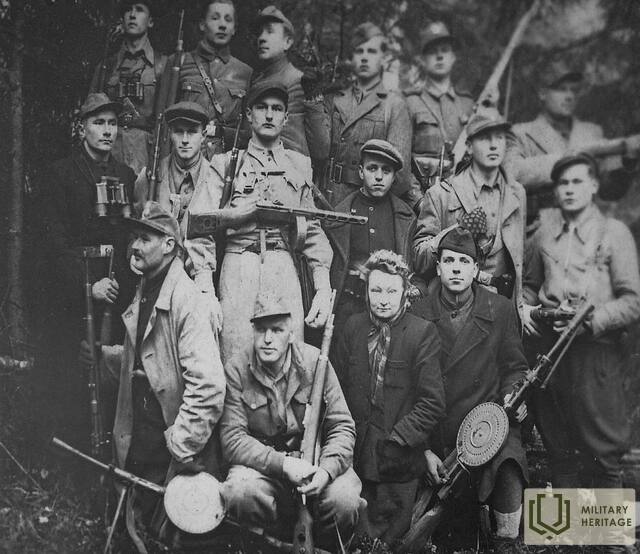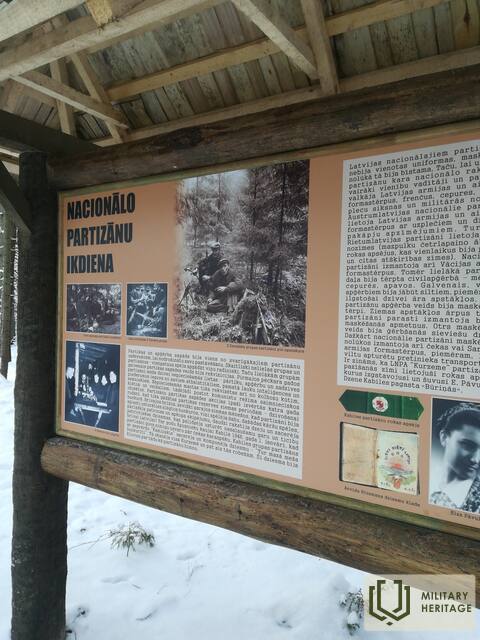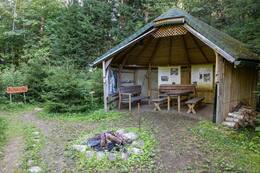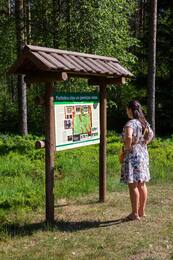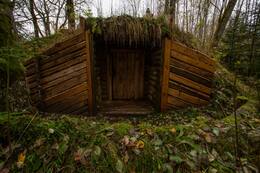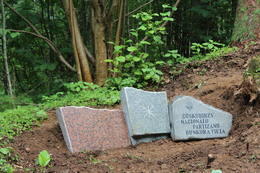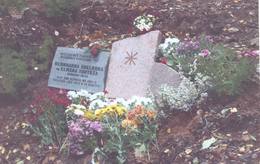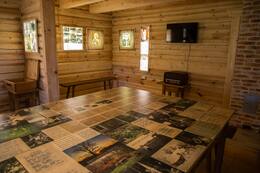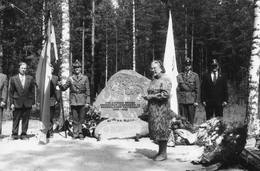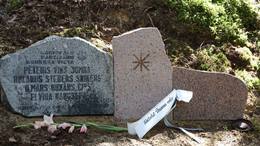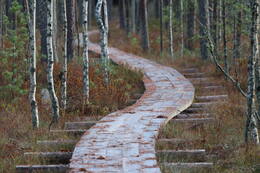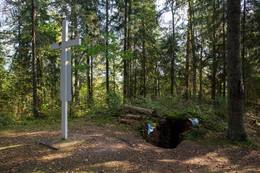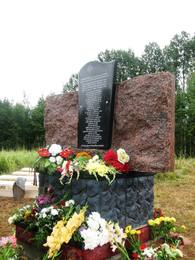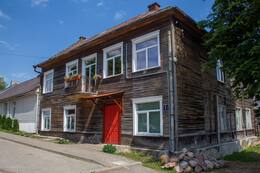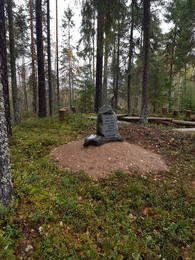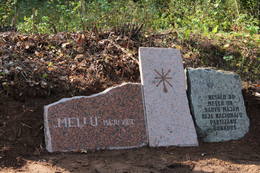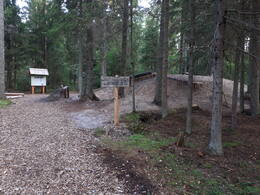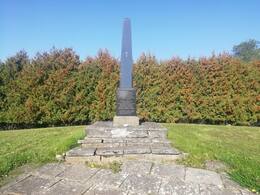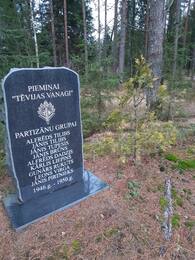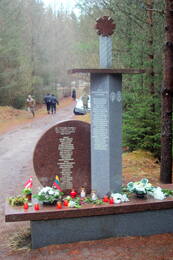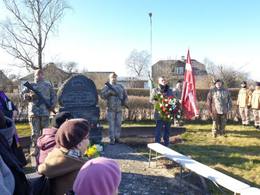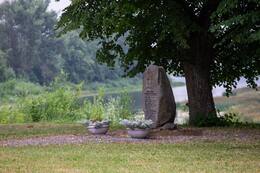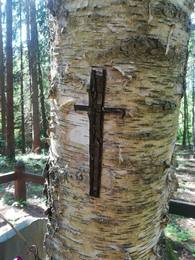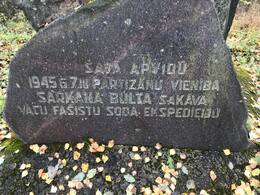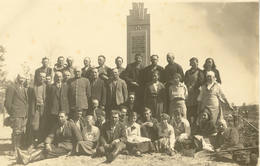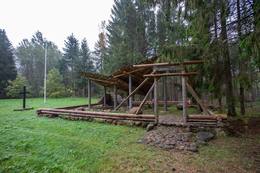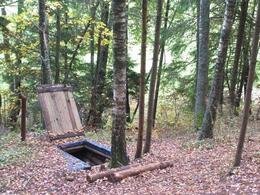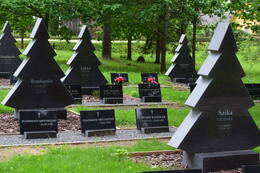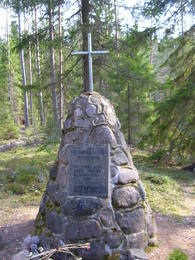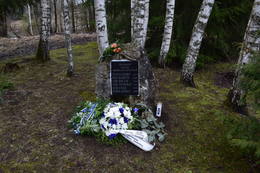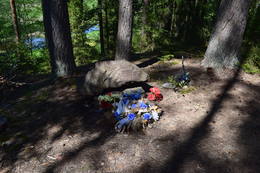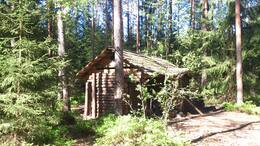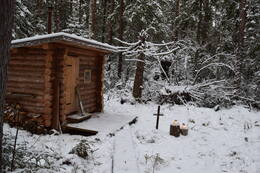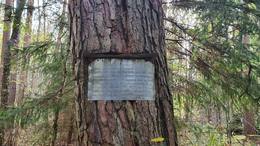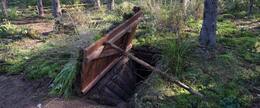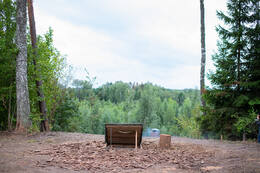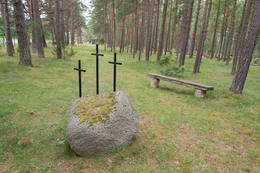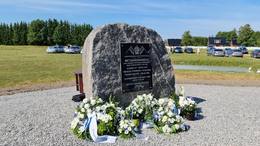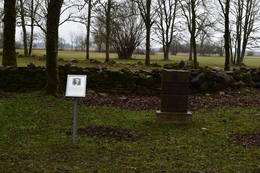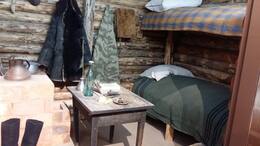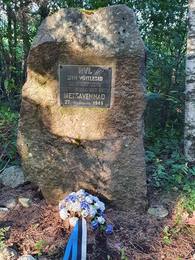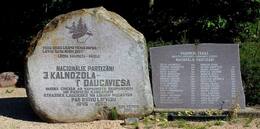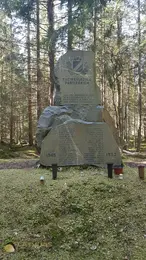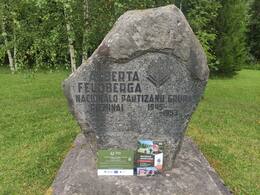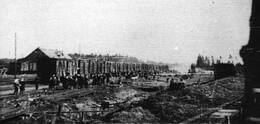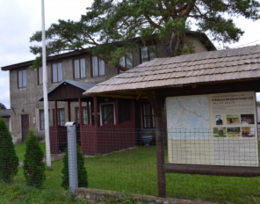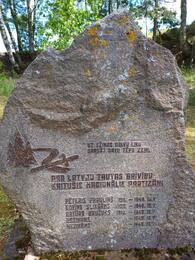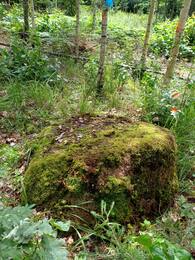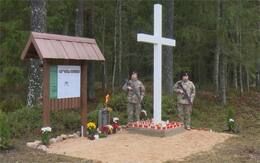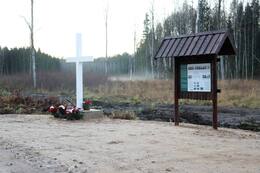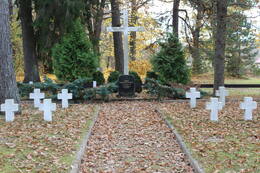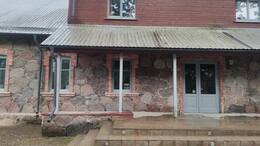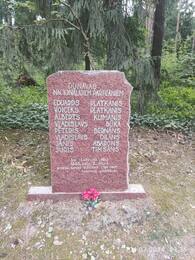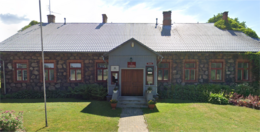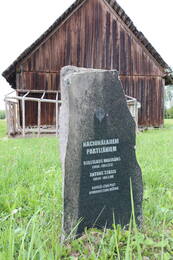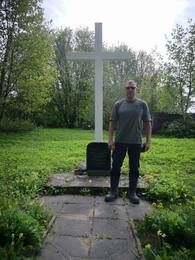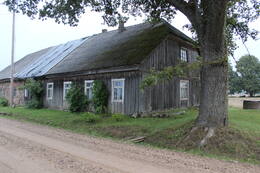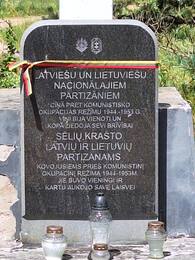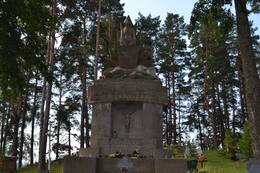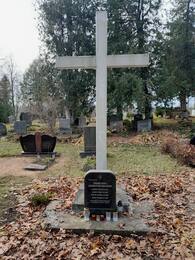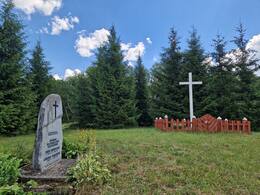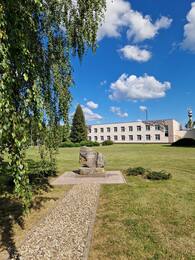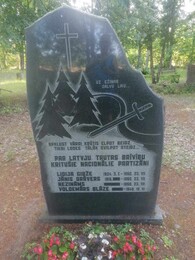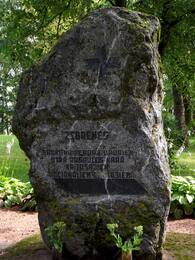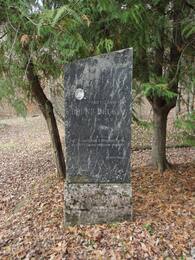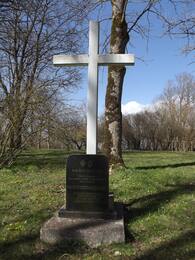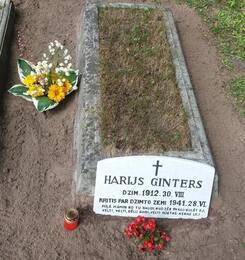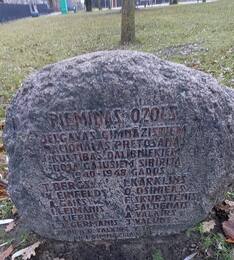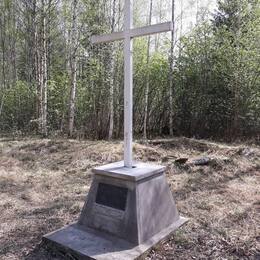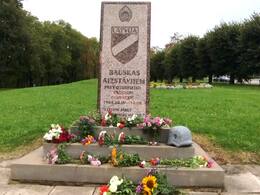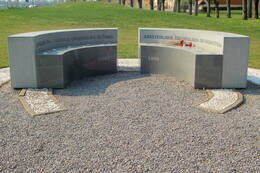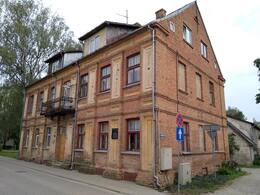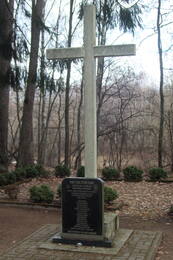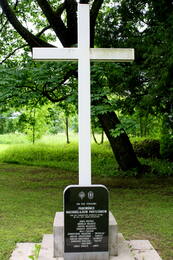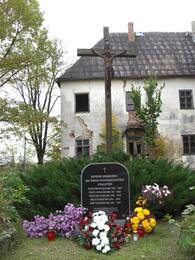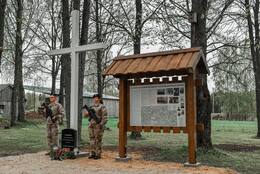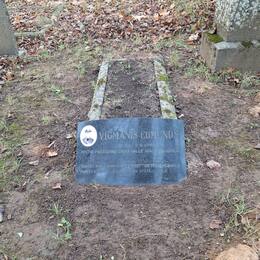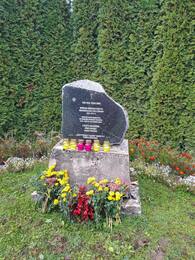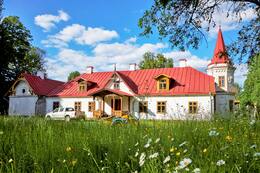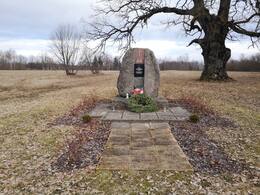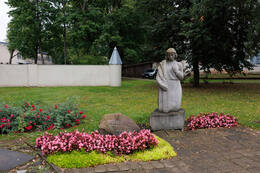National partisans/ Forest brothers
II World War II, III National Partizans
The national partisans or Forest Brothers were small, armed groups of local residents who fought their independent battles against the occupation regime of the USSR in the territory of Latvia from 1944 to 1956.
Forced to hide in the forests, these were people who could not or did not want to live in the Soviet Union. They were residents of Latvia who fought the occupation regime of the USSR from August 1944 to May 1957 through armed struggle and guerrilla warfare.
Partisan battles with the forces of the occupation regimes took place starting from the late summer of 1944.
In total, there were approximately 20193 forest brothers/ national partisans in Latvia
More information sources
Latvian national partisan struggles - National Encyclopedia (enciklopedija.lv)
Related timeline
Related objects
Bunker of national partisans – Forest Brothers
The Forest Brothers’ Bunker is located by the Riga-Pskov (A2) highway 76 kilometres from Riga and 11 kilometres from Cēsis. The Latvian national partisans or Forest Brothers were small, armed groups of local residents who fought their independent battles against the occupation regime of the USSR in the territory of Latvia from 1944 to 1956. Forced to hide in the forests, these were people who could not or did not want to live in the Soviet Union. A total of around 20,193 Forest Brothers operated in Latvia. The bunker was formed based on the stories and memories of former Forest Brothers about life in the forests, hiding and fighting for the independent state of Latvia after 1945. The bunker showcases armaments and household items. The personal belongings, weapons and photos of partisans are on display. The guide’s narration is enriched by a video from interviews with Forest Brothers. There is a place for picnic campfires by the bunker. It is possible to pre-order a soup prepared on the fire or enjoy an evening of outdoor cinema by the fire.
National and Soviet partisan battles and memorial sites in the Grīva Forest
Located in the Grīva forest massif.
Six objects related to the sites of national and Soviet partisan battles can be viewed.
The Grīva forest massif is home to not only the headquarters of the “Purvsaliņi” national partisans, the White Cross in the national partisan bunker and the cross to the commander of the resistance movement Andrejs Roskošs, but also the grave of the commander of the Soviet partisan brigade Artūrs Baložs, a monument on the so-called Meiteņu kalninė, where a group of young partisans of the Soviet partisan brigade perished in 1944, as well as a monument to Soviet partisans with a five-pointed star and the engraved words “We covered ourselves with our needles.”
The objects can also be viewed by going on a bicycle ride on cycle route No. 785 - "Historical Rhymes in the Grīva Forests" (route length 34 km, gravel and forest roads). Map for download.
Memorial to the commander of the national partisan group Andrejs Roskošs (GPS 56.87399, 27.43524)
In the autumn of 1997, a White Cross was unveiled in the Lielgrīva Forest for the commander of the national partisan group, Andrejs Roskoš.
Monument to Artūrs Balodis (GPS 56.872926, 27.478121)
Artūrs Balodis was a Soviet partisan, a special operations commander for the A subunit, which was stationed in the Grīva forest massif. He fell during a large-scale “combing” carried out by the Nazi German occupiers. His comrades carved the letters AB into a birch tree at the place where he died so that he would not forget it. After the war, local historians found the marked birch tree and installed a memorial plaque in its place.
To all those who fell in the Grīva forests (GPS 56.863280, 27.47975)
This memorial stone in the Grīva forest massif has been installed by the State Enterprise “Latvijas valsts meži” in honor of the partisans who fought for their homeland. Next to the memorial stone is a map-scheme with indications of partisan headquarters - sightseeing objects. A recreation area has also been established. Nearby is the site of the national partisan settlement, 1945-1947.
National partisan settlement site (GPS 56.863456, 27.481148)
This place was home to the settlements of national partisans who fought against the Soviet occupation. The sites of individual bunkers have survived, from the visual appearance of which one can judge how large and what shape the dugouts were. National partisans, resisting Soviet rule, operated in the Grīva forests for several years after the end of World War II.
Girls' Hill (GPS 56.858187, 27.521526)
In June 1944, the Nazi German occupiers carried out a large-scale “combing” of the Grīva forests with the aim of destroying the partisans. The soldiers surrounded the farm company on Numerne Hill, which consisted mostly of young girls, and all of them were shot. Since these tragic events, the locals have renamed Numerne Hill as Meiteņu Hill. A memorial stone has been erected at this place.
Monument to the commander of the North-Eastern national partisans Pēteris Supe - "Cinītis"
In honor of the memory of the national partisan commander Pēteris Supe, a monument dedicated to him was unveiled in Viļaka on May 28, 2005. It is located near the Viļaka Catholic Church, on the edge of the trenches dug during the war, where the Chekists buried the national partisans who were shot. Under the monument dedicated to P. Supe, a capsule with the names of 386 fallen national partisans, descriptions of battles and materials about the partisan commander is placed. The words are carved into the stone: "To you, Latvia, I remained faithful until my last breath."
The monument was designed by Pēteris Kravalis.
Nearby is a memorial to the Latvian freedom fighters who fell in Stompaku Forest and other battle sites and were murdered by the Chekists in 1944-1956.
On June 20, 2008, a granite plaque was unveiled on the right wall with the names of 55 fallen partisans arranged in three columns.
The monument was erected at the site where the communist occupation authorities had once exhibited the remains of murdered partisans to intimidate the rest of the population.
On the adjacent plaque are engraved words of gratitude to Pēteris Supe and a poem by Bronislava Martuževa:
"Get up, Peter Supe,
Soul, fight in the war!
Today is your blood sacrifice,
Risen among the people.
Go out and live forever
In the strength and vigor of youth,
It flutters, flutters, flutters
"In the rising flag!"
Memorial site of national partisans in Sērmūkši
Sērmūkši is home to one of more than a hundred memorials to partisan battles in Latvia. There are more than six hundred partisan battle sites in Latvia. A Latvian national partisan dugout has been built based on historical evidence, and visitors can spend the night in near-authentic conditions with plank beds, lighting provided by kerosene lamps and a heating device similar to the ones used by partisans. Visits must be booked in advance. The fateful moment for the Sērmūkši National Partisan Group came on 29 November 1946 with the deaths of four fighters from the group: Jānis Zīrāks, Reinholds Pētersons, Jānis Pīlands and Anna Zariņa. Alfrēds Suipe survived, endured deportation, returned to Latvia and saw the restoration of a free state. He initiated the idea to establish a memorial site for his fallen companions in Sērmūkši.
Memorial stone to the national partisans of Alsviķi parish in "Čūskubirzī"
Located in “Čūskubirzs”, Alsviķi parish, Alūksne municipality.
The memorial stone was unveiled on August 21, 2018. Stonemason Ainārs Zelčs.
Here, in the forest massif, the site of a bunker has been preserved, where in June 1947, Antons Circāns, the head of the communications department of the General Staff of the Latvian National Partisan Association, arrived for a meeting with partisan representatives led by Bruno Bukalders, in order to organize and maintain communications between individual national partisan groups. Antons Circāns' goal was not realized, as he died on July 7, 1947, near Drusti.
Memorial plaque to the Veclaicene national partisans at the site of the bunker
Located in Veclaicene parish, Alūksne region.
Opened on October 4, 2019. Stonemason Ainārs Zelčs.
On March 13, 1953, in the Veclaicene forests near the "Koruļi" houses, the Chekists discovered a carefully camouflaged bunker and arrested Bernhards Ābelkoks and Elmārs Tortūz.
Weapons were found in the bunker: 2 German rifles and 95 cartridges, 2 “Parabellum” pistols and 152 cartridges.
On November 11, 1949, Cheka agents shot K. Dokti-Dokteniekus, and his group disintegrated. After the attack, B. Ābelkoks and E. Tortūzis hid for some time in a bunker near the “Maskaļi” houses, but from the spring of 1951, with the support of Ilona Ābolkalna, they set up a bunker in “Koruļi”, where they lived until their arrest.
Broņislava Martuževa poetry barn
The Broņislava Martuževa Museum is situated on the site of the poet’s childhood home in Indrāni parish, Madona municipality. The museum’s exhibit is located in a renovated barn featuring voice and video evidence from the National Resistance Movement and the work of the poet in publishing an underground magazine, as well as composing poetry and songs for national partisans. Broņislava Martuževa was involved with the resistance movement since its inception. Lazdiņas, Martuževa’s home which has not survived, also served as a place of refuge for Pēteris Supe, Head of the Latvian National Partisan Association, and his comrades-in-arms. The poet spent five years hiding in the basement of her home, meeting with partisans, writing poetry (including work dedicated to partisans Pēteris Supe, Vilis Toms, Smilga Group, Laivenieks, Salns, Celmiņš, Bruno Dundurs and others), as well as writing songs and teaching them to partisans. Now, her songs are sung by the ‘Baltie lāči’ group (literally: ‘White Bears’). In 1950, the ‘Dzimtene’ magazine (literally: ‘Motherland’) was published underground together with Vilis Toms. The poet transcribed 11 issues of the magazine, 10 copies each, by hand. The poet, her brother, sister, mother and Vilis Toms were arrested in 1951. Bronislava Martuževa returned from Siberia in 1956. Recognised locally and nationally, the poetry barn is visited by both local residents and guests of the municipality. Learning about the poet’s life gives you the opportunity to discover the fate of Latvia.
Memorial to the fallen Latvian Legion soldiers and national partisans
Located in the Lubāna New Cemetery in Indrāni Parish.
A memorial site to the fallen Latvian Legion soldiers and national partisans is open for viewing.
The memorial was opened on July 25, 1992. The memorial stone was created by Andris Briezis.
As the Awakening began, in October 1990, Kārlis Doropolskis, a member of the human rights group “Helsinki 86”, received permission from the authorities to begin the reburial of Latvian legionnaires who had fallen and been buried scattered around Lubāna in the summer of 1944, as well as national partisans who had fallen in later battles with the Soviet occupation troops and security institutions, in common mass graves, which were arranged in the new cemetery in Lubāna. In total, 26 fallen legionnaires and national partisans were buried in mass graves.
Memorial site of the bunker of the national partisan group “Jumba”
Located in Ziemers parish, in the 66th block of the State Forest.
The memorial was opened on July 10, 2020.
In the second stage of the Latvian national partisan movement, in mid-1948, a group of 4 people - Viks Pētersi, Stebers Rolands, Bukāns Ilgmārs and Kangsepa Elvīra separated from the J. Bitāns-Liepačs unit in the territory of Mālupē-Beja parishes and began independent activities in Ziemera-Jaunlaicene-Veclaicene parishes. The partisan headquarters was near the Estonian border, not far from the Riga-Pskov highway, on a hill, in a well-built bunker.
On March 2, 1950, when the Chekists discovered the bunker, the partisans hid in a barn built of boulders in the “Napke” house on the Estonian side. After a long and intense firefight, on March 3, 1950, the Chekists managed to set the barn on fire. Ilgmārs Bukāns, Rolands Stebers, and Elvīra Kangsepa burned to death along with their newborn daughter. Pēteris Viks jumped out of the barn window and hid in the attic of the house, where he was found and shot. The farm was burned down. The bodies of all the fallen partisans were taken to Alūksne. A memorial sign was erected at the site of the fighters’ deaths in the early 1990s. Elvīra Kangsepa’s daughter, who was born in the burning barn, was named Liesma.
Trail and partisan memorial in Stompaki bog
During World War II, one of the largest national partisan camps in the Baltic states was situated in Stompaki Swamp. Today, the territory is included in the nature reserve “Stompaki swamp”. The settlement sites located on the islands in the swamp can be reached via a marked footpath.
In early 1945, about 350 to 360 people, including 40 to 50 women, lived at the camp of National Partisans in Stompaki Swamp. The camp consisted of 24 residential bunkers – buildings that were half-immersed into the ground and could accommodate 3–8 people. There was a bakery, a church bunker and three above-ground rails for horses. Partisans from the camp carried out attacks against officials of the occupation regime. On 2–3 March 1945, the Battle of Stompaki took place here – the largest battle in the history of Latvian national partisans. The 350–360 partisans in the camp were attacked by the 143rd Rifle Regiment of NKVD and local fighters of the so-called ‘istrebitel’ (eliminators) battalion – 483 men in total. The battle lasted for the entire duration of the day on 2 March. On the night of 3 March, the partisans managed to break out of the camp and retreat to their previous base camps. The battle resulted in 28 casualties among partisans, while the NKVD force lost 32 fighters.
Today, the site of the Stompaki camp is home to three restored bunkers – a church, a headquarters and a residential bunker – as well as 21 sites of former bunkers. Information boards about the camp and the battle have been installed at the site. Guided tours can be booked.
Partisan Dugout Shelter of Veseta and “White Cross” Memorial Site
The Veseta Partisan Dugout and the “White Cross” memorial site are located in the Veseta floodplain swamp.
After the Second World War, the so-called Pārups Group was operating in Vietalva. Rihards Pārups (1914–1946) was the leader of the group. During the Second World War, he was a sergeant of the 15th Latvian Division of the German Army. He participated in national partisan operations in the vicinity of Jēkabpils and Madona. During its short existence, Pārups Group took part in more than 20 armed clashes with the units of the Ministry of the Interior of the time.
The Colonel Kotov of Cheka, in his report to his superiors in Riga, indicated that, as a result of the activities of the group, the Soviet authorities in the Jēkabpils and Madona districts were paralysed. National partisans led by Pārups found and destroyed several deportation lists, thus saving the lives of multiple people. Unable to destroy the national partisan unit in open combat, the leadership of the Soviet Security Committee infiltrated four members of the Cheka special force into the group. On the night of 2 July 1946, these agents shot ten partisans of the unit, including Rihards Pārups. The burial place of the fallen is unknown, but a commemorative plaque has been erected at the Brothers’ Cemetery in Riga to commemorate them. The “White Cross” memorial site is situated next to Veseta Partisans Dugout. It is a 3-metre-high white cross with a plaque inscribed with the names of partisans who fell on 2 July 1946.
Monument to the participants of the resistance movement in Stompaki
Located 15 km from Balvi in the direction of Viļaka, on the right side of the road.
A memorial sign is visible.
A memorial to the participants of the resistance movement, dedicated to the memory of the national partisans of Pēteris Supe who fell in the battles of March 2 and 3, 1945, was unveiled on the side of the Balvu - Viļakas highway opposite the Stompaku swamp on August 11, 2011, on the Day of Remembrance of Latvian Freedom Fighters. At the end of July, a capsule with a message for future generations was embedded in the foundation of the monument. A document with the names of 28 national partisans who fell in the battles of March 2 and 3, 1945 is placed in the capsule.
"In February 1945, on the islands of the Stompaku swamp, which the people began to call the Stompaku swamp islets, 2 km from the Balvi - Viļaka highway, the largest national partisan camp in Latvia was established, where 360 people lived in 22 dugouts. Among them were some legionnaires who, when the legion division retreated, had remained at their father's house with all their weapons. In order to destroy the partisans, on March 2, 1945, soldiers from two Cheka battalions attacked the dugouts together with destroyers, who also had four mortars in their armament. The fighting lasted all day, the partisans resisted stubbornly, and the attackers suffered heavy losses, so that they were unable to take the camp and destroy the partisans. 28 residents of the Stompaku swamp had also fallen in the battle or died from serious injuries. The next night, the partisans broke through the camps with a battle "the siege and left undefeated" - this is what Zigfrīds Berķis, the chairman of the Commission for the Affairs of the National Resistance Movement Participants of the Awards Department, writes about the Battle of Stompak.
Private Exhibition “Abrene Rooms”
The Private exhibition “Abrene Rooms” is located in the town of Viļaka, in a building with a diverse history. Initially, the building was located on the old Marienhausen market square, later it housed apartments, offices and various shops, and during World War II, it was the Latvian self-defence headquarters, the Gestapo and also the Cheka. Several exhibitions reveal diverse events and historical periods in the town of Viļaka and its nearest vicinity covering the time period from 1920 to 1960 when Viļaka was part of Jaunlatgale, later Abrene, district. The exhibit features items from the national partisan camp in Stompaki Swamp, which are related to the national partisan movement in the Latgale region. Documents and photos associated with the War of Independence are also on display. The latest exhibition is dedicated to the once-famous motocross track “Baltais briedis”.
Memorial site "Bitāna Bunkers"
Located in Mālupe parish, Alūksne municipality.
The memorial stone was unveiled on October 13, 2017. Stonemason Ainārs Zelčs.
On August 24, 1945, in Latgale, in the Dubna forests, the Latvian National Partisan Association (LNPA) was founded with the aim of restoring the 1918 Republic of Latvia. For better coordination of the activities of the partisan groups, regional headquarters were established. The national partisan groups operating in the Beja, Mālupė, and Mārkalne parishes united in the “Priedolaine” sector. The regional headquarters was headed by Jānis Liepacis. Propaganda departments were established in each regional headquarters. One of these, commanded by Jānis Bitāns, was established in the forest massif of Mālupė parish. Here, in the bunker, from 1946 to 1948, five press publications of the Latvian National Partisan Association were printed: “Mazais Latvis”, “Liesma”, “Auseklis”, “Māras Zeme” and “Tautas Sargs”. The Alūksne Gymnasium youth resistance movement “Dzimtenes Sili” was involved in the preparation and dissemination of information.
Memorial stone in Ilzene near the houses of “Sarvi” and “Meļļi”.
Located in Ilzene parish, Alūksne municipality.
The memorial stone was unveiled on September 28, 2018. Stonemason Ainārs Zelčs.
The residents of these houses in Ilzene parish from the autumn of 1944 supported the national partisans led by Voldemars Andersons (“Vecs”), whose bunker was located nearby in the thicket of the forest. On November 23, 1945, the bunker was surrounded by NKVD soldiers. Nine fighters died in the battle. After it, 2 machine guns, 14 automatic rifles, 11 rifles, 10 pistols, 3,500 cartridges, 45 grenades, 4 binoculars were found. The destruction of Voldemars Anderson’s group was planned in the Cheka agency’s case “Chain” (“Цепь”).
The group consisted of Voldemārs Pāvels Andersons ("Vecais"), Gastons Dzelzkalējs, Voldemārs Tonnis, Centis Eizāns, Osvalds Kalējs, Jānis Koemets, Stāvais ("Polis"), Voldemārs Rappa, Eduards Rappa, Elmārs Rappa (remained alive).
Preiļi Museum of History and Applied Arts exhibition "Museum Stories for Latvia"
Located in the premises of the Preiļi Cultural Center.
The Preiļi Museum of History and Applied Arts (PVLMM) exhibition "Museum Stories for Latvia" about the First World War, the War of Independence and the Second World War is on display.
The section "The Story of Drywys" of the Preili History and Applied Arts Museum's exposition "Museum Stories for Latvia" (opened in 2018) is dedicated to the First World War, the War of Independence and the liberation of Latgale, as well as the Cavaliers of the Lāčplēšana War Order. The section of the exposition "The Story of the Flag" tells about the complex events of the Second World War, during which the people of Preili were affected by deportations, the Holocaust, involvement in the military units of the warring parties, and after the war - in the ranks of the national partisans. The medal "Righteous Among Nations" awarded to the Preili resident and Jewish rescuer Vladislavs Vuškāns is also on display.
Tours are available in Russian and English by prior arrangement.
Pēteris Čevers national partisan bunker
The bunker of the national partisans of Peter Chever is located in Lauciene municipality, about 4 km from the Talsi-Upesgrīva road. A trail covered with wood chips leads to the bunker. The renovated 31 square metre bunker is made of a concrete frame finished with half-logs of logs to create an authentic feel.
Captain Chever's group completed the bunker in the forest near Vangzene at the end of October 1949. It was planned to survive the winter of 1949-50. On 3 February 1950, the local forester betrayed the partisans and the bunker was attacked by a Cheka unit of more than 300 soldiers. At that time there were 19 people in the bunker - 17 men and two women. Six partisans fell in this unequal battle, but the others managed to break through two chains of Cheka siege by fighting their way through. By the end of the winter the partisans took refuge in surrounding houses with their supporters, but in the spring the group reunited until it was captured and destroyed in November 1950. After an attack by Cheka troops, the bunker was blown up and before it could be rebuilt, only a water-filled pit remained.
Zlēku Tragedy Memorial Site
The memorial is located near the Zlēki Manor ensemble, in the western part of Karātavkalns. Around twenty boulders with the names of the people killed form a circle, and in the centre is a black marble obelisk about three metres high.
Some of those killed have been reburied at the Zlēki memorial.
In December 1944, in the vicinity of Zlēki, the German Nazi army carried out a large-scale operation against the civilian population.In the combat action log of Army Group Nord, an entry was made at 17.30 on 9 December 1944 that 161 people belonging to the "Rubens Brigade and units of the Red Arrow" had been killed on the enemy side during the action. In Soviet times, this figure was apparently taken as the total number of victims of the Zlēki tragedy, referring to civilians killed.
The course of the action is partly documented in the report of the head of the counter-intelligence section of the German 16th Army of 31 December 1944. It explains that from 5 to 9 December, under the leadership of the highest SS and police leader in Ostland, SS Oberruppenführer and Police General Friedrich Jekeln, a large-scale operation took place at Eichensumpf ("Oak Swamp") against the "Red Arrows" and the remnants of General Kurel's group at Abava.
"Dunci's bunker" and memorial plaque to "Tēvijas vanagi" (Patriotic Hawks)
The "Duncs Bunker" with the memorial plaque "Patriotic Hawks" is located in Otaņķu municipality, in the place where the first bunker of the partisan group of the national resistance organisation "Patriotic Hawks" was located.
In the winter of 1945/46, in the village of Ķīburi in Barta parish, three patriotic men, led by Alfred Tilib (a former legionary of the 19th SS Division), founded the national resistance movement "Tēvijas Hawks", which soon had about 200 members from different places: Liepāja, Aizpute, Nīca, Dunika, Grobiņa, Barta, Gavieze. This movement fought for the liberation of Latvia.
The size of the bunker in which the partisans were housed was 4 x 4 m and was made of thick, horizontally laid logs. It was entered from above through a trapdoor with a small pine tree growing out of it, under which was a ladder. The hatches were on two floors, each with a place for 7-8 men to sleep. Unfortunately, the bunker was found and blown up in 1947.
Today, a depression can be seen in the ground where the bunker was. The site is located in the forest and can be freely accessed by anyone at any time without prior reservation.
A picnic area with a shelter is available nearby.
The memorial plaque was unveiled on 9 September 2005. The granite stele was erected by the Latvian National Partisans' Association in cooperation with the Municipality of Nīca, the Barta Forestry and the Rudes Primary School.
The object has the status of a cultural and historical monument of the region
Īle National Partisan Bunker
The bunker is located in the Īle forestry of Zebrene Rural Territory, at the turn-off from the P104 Biksti-Auce Road.
The Kārlis Krauja Group of Īle National Partisans was formed in 1947. V. Z. Brizga (alias K. Krauja) was appointed the commander of the group. In October 1948, the Krauja Group merged with a group of Lithuanian national partisans. Krauja Group operated in Jelgava District and consisted of 27 national partisans.
In October 1948, Krauja Group built an underground bunker in Lielauce Parish, Jelgava County, not far from the Īle Forestry, 300 metres to the north of the “Priedaišu” house. Its total length, including battle passages, was 45 metres. 70 remote-controlled mines were planted around the bunker. The bunker was equipped with a furnace, a well, a toilet, and a storage room.
On 17 March 1949, the 24 partisans who were in the bunker at the time fought their last battle against the 760-strong troops of the Ministry of National Security or Cheka. After the battle, 9 members of the group were arrested, while 15 fell in the battle, with eight of them being Latvian and seven being Lithuanian. In 1992, the Home Guards, together with the Daugavas Vanagi (Hawks of the Daugava), unearthed the bunker that had been blown up. A White Cross, a memorial stone and a granite statue were erected at the site.
Inside the bunker, you can see a stove, a table, and narrow benches on which the partisans slept. Information boards and memorial stones with the names of the partisans have been installed at the bunker.
National Partisans Memorial Site on Striķu Street, Saldus
The memorial is located at the intersection of Striķu and Lauku Street.
The tragically bloody event that took place at this place took place during peacetime on 24 February 1950 in Saldus, on Striķu (then 5. augusta) Street, near the 33rd and 35th houses. In the 33rd house of this street, after the destruction of the Zemgale group of forest brigades with its headquarters bunker in the forests of Īle in March 1949, three forest brigades were still alive and uncaptured, including the group commander himself, Kārlis Krauja (real name Visvaldis Brizga), and his associate Vilis Krusts. They had hoped to spend the winter of 1950 at the Bergmanis' home in Saldus, but they were rounded up and tracked down. The two houses were besieged by about 30 Chekists and a fierce battle took place early in the morning. The Chekists were fired on from both houses, but, losing to overwhelming odds, the two partisans tried to escape to the nearby Veide forest. However, the Chekists shot partisan Krusta already on the stairs of the house, and Krauja - about 80 metres further towards the forest.
Both houses were set on fire, the occupants having been asked to come out beforehand and promised that their lives would be spared. There are reports that people did come out, but they were shot on the spot anyway. Among the people shot or suffocating in the smoke were the father and son Kursinski from House 35, who had supported the partisans, but also Leontine Ezerkalni, a resident of the Kursinski house, who had no knowledge of her landlord's connections with the forest brigades, was shot.
Memorial stone to Rihards Pārups' national partisan group
Located on Riga Street near the Krustpils Lutheran Church.
On September 22, 1996, a memorial stone was unveiled in Krustpils to Rihards Pārups and the national partisan group he led. The memorial stone was created by sculptor Ilgvars Mozulāns, and its creation was financially supported by the Speaker of the Saeima, Ilga Kreituse. This event was organized by the board of the Latvian National Partisan Association.
To the national partisans of Rihards Pārup,
who were murdered by a Cheka special group
Richard Parups (1914 – 2nd July 1946)
Group commander
Richard Stulpins (1923 – 1946. 2. VII)
Alberts Avotiņš (1912 – 2 July 1946)
Erik Juhna (1928 - 2 July 1946)
Aleksandrs Lācis (1919 – 2 July 1946)
Peter the Bear (1921 – 1946, 2nd July)
Jānis Ēvalds Zālītis (Āboliņš) (1911 – 1946, 2nd July)
Siegfried Bimstein, Theodore Schmidt (… – 2 July 1946)
Uldis Šmits (... - 1946. 2. VII)
Peter Lazdans (1926 – 1947)
Erik Konval (1929 – 1947. VI)
Niklāss Ošiņš (1908 – 12 October 1954) – executed in Riga
Alberts ħiķauka (1911 – 1972 II) – imprisoned in the Mordovian camp
Rihards Pārups was born on June 11, 1914 in “Kaķīši” of Krustpils parish. During World War II, he was a sergeant of the anti-tank division of the 15th Latvian division. He participated in national partisan operations in the Jēkabpils and Madona areas and was a member of the National Resistance Movement, the leader of a unit in the Jēkabpils and Madona areas. Rihards Pārups fell in battle with Cheka troops on July 2, 1946 in Vietalva parish. Unfortunately, the place of burial is unknown. A memorial plaque has been installed in the Riga Brothers' Cemetery. In the autumn of 1945, a national partisan group was formed in Jēkabpils district, led by R. Pārups. During its short existence, it participated in more than twenty armed clashes with units of the then Ministry of the Interior. The report of the Cheka Colonel Kotov to the Riga leadership states that the activities of the Soviet government in the Jēkabpils and Madona districts were effectively paralyzed during this time as a result of the group's activities. The national partisans led by R. Pārup found and destroyed several lists of deportations, thus saving the lives of many people. The leadership of the Security Committee, unable to destroy the national partisan unit in open battle, infiltrated it with four people from the Cheka special group, who shot ten partisans of the unit, including R. Pārup. In 1947, two more were shot near Jaunkalsnava, and in 1951 — one member of this unit. After twenty-five years of hard labor in a Mordovian camp, the fourteenth partisan of the group led by R. Pārup died a few days before liberation.
National Partisans battle site near the Apūznieki home
On 1 January 1946, one of the biggest battles between the national partisans and the Cheka, or Soviet occupation State Security Committee, took place between Kabila and Renda near the "Apūznieki" houses. The partisans, among whom was the commander of the group, Fricis Kārkliņš, went after hay on the horses of the forest brigades. He left Ēvalds Pakulis as commander. The scouts reported that a Cheka unit was approaching the dugouts. Pakulis sent a partisan detachment - 25 well-armed men - to meet them. The bullets of the enemy wiped out the lives of three men - Kārlis Kristolds, Emītis Šmits and Ādolfs Kūrējs - but about 50 men fell on the Cheka side. Two of the fallen men are buried in the forest where these events once took place, and a memorial to them has been created.
Today, new bunkers are being discovered in the forests, which once sheltered almost 20 000 people who did not support the Soviet occupation and were uncooperative, or who hid in the forests for other reasons, such as fear for their lives, safety, etc.
Memorial stone of the Soviet partisan unit "Red Arrow"
The Soviet partisan unit was formed on 30 September 1944, when 19 soldiers of the German 283rd Police Battalion, under the leadership of Vladimir Semyonov, deserted with their weapons. The battalion was formed in 1943 from volunteers from the Latgale region and took part in the anti-partisan operations of the German occupation authorities in the territory of Latvia and Belarus.
The unit was called "Semyonov Unit" after its commander and only at the end of the war adopted the name of "Red Arrows", which was already spread by Soviet propaganda after WWII. By December 1944, the unit had 300-400 partisans. Most of them were escaped Red Army soldiers, former Legionnaires, including fighters left after the destruction of General Kurel's group. Although many Red Army reconnaissance groups were active in Kurzeme at this time, they avoided close cooperation because the activities of the commander of the partisan unit and its main core in the ranks of the German police were too suspicious. The Red Arrow's activities were relatively poorly organised and more focused on waiting for the end of the war. During its activities it carried out extensive terrorising of the local population.
Vladimir Semyonov, the first commander of the Red Arrow, drowned on the night of 10 December 1944 while knee deep tried to cross the swollen Abava River. His corpse was found only in the spring of 1945 and buried. He was reburied in Kuldīga in 1961.
The monument is located on the site of the "Red Arrow" and other guerrilla camps in the area (about 50-70 people), which on 7 March 1945 was surrounded and attempted to be destroyed by German troops.
Monument to the soldiers of Anna Parish who fell in World War I and the Latvian Liberation War
Located in the central part of the Ezeriņi cemetery in Anna parish.
In the cemetery, where burials have been held since 1925, there is a monument erected with funds collected by the Annas parish Guards Department and opened in 1933 to the soldiers of Annas parish who fell in World War I and the Latvian Liberation War. Until World War II, the Annas parish guards took care of the maintenance of the monument, who went to the cemetery every Sunday and, honoring the fallen, laid flowers. On November 18, 1940, the monument was shot down, the traces left by the bullets are still visible. Nowadays, commemorative events dedicated to Lāčplēsis Day are held in the cemetery every year.
In 2004, a memorial site was opened in the cemetery for those politically repressed in 1941 and 1949, and in 2006, a memorial plaque was opened for national partisans.
Historical Exposition “The Burning Conscience”
The historical exhibit ‘Fire of Conscience’ is located in Cēsis, near the Cēsis Castle Square. Established in a Soviet-era temporary detention facility, it tells about the occupation of Latvia and reveals surprising and heroic stories of resistance from individuals. The yard features a memorial wall with the names of 643 residents of the former Cēsis district who died in Soviet repressions, including national partisans deported in 1941 and 1949 and those shot and sentenced to death. The exhibit’s timeline encourages visitors to study the course of the occupation of Latvia from 1939 to 1957. Arranged by topics, quotes from local newspapers offer a comparison of the political propaganda of the two occupation regimes. The six cells for temporary detention have survived to the present day in their original form from 1940 to 1941 and the post-war years. Here, the residents of Cēsis district, detained for various anti-Soviet activities, including national partisans, their supporters, young people who distributed anti-Soviet leaflets and other ‘traitors of the motherland’, were held for several days during the initial investigation and interrogation before being sent to the main KGB Building in Riga. Everything here is real: cells with iron doors, built-in ‘kormushkas’ (small openings for providing food), plank beds, a latrine for detainees, a small kitchen with an oven, as well as typical Soviet-era oil paint on the walls. In 2019, the exhibit was ranked third in the national design competition, the Latvian Design of the Year Award.
Memorial site "Daiņkalni" of the national partisans led by Dailonis Breikšis
Located in “Daiņkalni”, Rauna parish, Rauna region (near the “Mežviju” houses in Smiltene region, Branti parish.
Access to the memorial site is only possible once a year - on April 16th! The road leads through private property.
The memorial site was established on the site of the former houses of “Daiņkalni” and “Graškalni” in Rauna parish, under which a group of national partisans led by Dailonis Breikšs (nickname Edgars, 1911-1952) hid in bunkers from 1950 to 1952. D. Breikšs’s national partisan group was established in 1948 and until 1950 they lived in “Jaunvieslavēni” in Gatarta parish with their landlord Kārlis Lāčis. In 1950, D. Breikšs’s partisan group was betrayed by his own brother Laimonis, so they were forced to move. They lived in the forests during the summers, but spent the winters in “Daiņkalni” in Rauna parish with forester Artūrs Pērkons (1907-1952) and in bunkers built under houses in the nearby “Graškalni”.
Since 2002, the memorial site in “Daiņkalni” has been gradually improved. Every year on April 16, memorial events are held in memory of the national partisans led by Dailonis Breikšs. In April 2003 and 2004, memorial crosses and plaques were dedicated near the houses of “Daiņkalni” and “Graškalni”. In the fall of 2016 - spring of 2017, with the help of local Raunė residents, the memorial site was reconstructed according to the sketches of architect Z. Butāns, and the site of the former bunker was excavated and strengthened.
Metsavenna Farm in Võrumaa
Forest Brother Farm is close to the Latvian border in the village of Vastse-Roosa.
The bunker tourism attraction was opened in 1999, offering visitors a chance to experience the Forest Brothers’ way of life as a chapter in Estonian history. The programme includes searching for Forest Brothers in the hideout, visiting the bunker, learning about real-life events, singing Forest Brother songs with the host and sampling a Forest Brother meal or feast. The main attraction is the bunker, which is lined with narrow pine logs and embedded in the hillside. The bunker is furnished with bunk beds and a small table. These types of bunker were used during the late 1940s and early 1950s by hundreds of brave men in the resistance, burdened by the need to hide from the authorities.
Memorial for Forest Brothers at Vastseliina
Plans for this Forest Brothers memorial were hatched in early 2013, when the Internal Security Service identified the bodies found in a mass grave in Reedopalo near Võru. With the cooperation of Vastseliina municipality, the Võru regional unit of the Estonian Defence League and the Ministry of Defence, the location in the cemetery was decided upon and the necessary preparations were carried out. The reinterment of the 13 Forest Brothers took place on 21 September 2013. A year later, memorial sculptures designed by Mati Karmin were unveiled here, depicting small spruce trees carved out of stone. On 1 November 2015 a further four Forest Brothers whose bodies had been recovered from the secret mass grave in Reedopalo were reinterred here and more memorial spruces were unveiled in remembrance of those fallen in three different battles. Their actual graves remain unknown to this day.
Monument to Forest Brothers in Puutli
The Puutlipalo monument and bunker site is situated in the village of Mutsu in Võru County. On 28 March 1953 the last large-scale skirmish took place between the Forest Brothers and the Soviet security forces in Puutlipalo. All eight people hiding in the woods were killed – three women and five men. The bunker was destroyed and the bodies brought out of the forest and buried in an unknown location.
This monument, dedicated to the fallen Forest Brothers, was unveiled on 20 May 1989 near the former site of the bunker. It was the first monument to Estonian resistance fighters erected while the country was still under Soviet occupation and the Forest Brothers were still officially referred to as bandits. Contrary to many similar monuments erected later, which were blown to pieces by the communists, the monument in Puutlipalo remained untouched owing to its hidden location. The original stone tablet is the only feature to have been replaced, as it was mistakenly inscribed (due to years of being kept secret by the state) with the name of a resistance fighter who died in another battle.
DNA tests done during an investigation by the Internal Security Service in January 2013 revealed the identities of the eight Forest Brothers killed in Puutlipalo. On Resistance Fighting Day that year they were reinterred in the cemetery in Vastseliina.
Memorial to Forest Brothers in Saika
The Battle of Saika Bunker took place on 7 March 1951. The skirmish, which lasted for four hours, was one of the few in the history of the Forest Brothers in which the Soviet forces racked up losses comparable to those of the Forest Brothers themselves. Out of the eight Forest Brothers in the bunker, only two managed to escape. They were killed two years later in the Battle of Puutlipalo.
The memorial was opened on St John's Day in 2007 next to the main road. Avid hikers will also find the site of the bunker if they follow the forest paths south-east of the memorial for 700 metres. Battle site coordinates: 57°39'22.2”, 27°18'49.9" Note: Note that the coordinates carved into the Saika memorial spruce in the cemetery in Vastseliina are inaccurate.
Death site of last Estonian Forest Brother August Sabbe
Here, on 28 September 1978, two intelligence officers attempted to capture 69-year-old August Sabbe, who had been hiding from Soviet authorities for almost 30 years. However, capturing him alive proved impossible – following a scuffle, Sabbe threw himself into the Võhandu River and drowned. His body was recovered, taken to Tartu and buried in an unmarked grave in Raadi cemetery on 20 October that year. On the same day two decades later, his grave was marked with a tombstone. In 2002 a memorial to him was placed on the banks of the Võhandu River. Sabbe's pistol is on display in the Forest Brothers section of the main exhibition at Võru County Museum.
Põrgupõhja Forest Brothers' Bunker
Põrgupõhja Bunker is situated in the woods near the village of Tiduvere in Rapla County.
By 1945 anti-Soviet dissent had developed into organised resistance movements in many occupied lands, including Estonia. Attempts were made to unify fighter groups and establish a network. This bunker, built in 1947, was an important stronghold for the Forest Brothers.
Fully reconstructed, Põrgupõhja Bunker was opened in 2015, showcasing the everyday life of the Forest Brothers. Anyone interested can spend the night in the bunker and imagine what it must have been like to live in hiding.
Adjacent to it is the original site of the bunker, which was destroyed by the NKVD on 31 December 1947, plus its surrounding dirt wall and a memorial to the fallen Forest Brothers.
Museum room on the Forest Brothers in Nursi Village Centre (with a memorial and a copy of a bunker nearby)
Entry is free and the museum room is open during the library's opening hours. The bunker is situated in an unrestricted part of the Defence Forces training area in Nursipalu. During training, gunfire can be heard in the vicinity. The last section of the road leading there may prove more demanding for drivers, but it is passable most of the time. The ground around the bunker can be wet.
The Battle of Lükka (Nursi) Bunker took place on 28 December 1945. Nine Forest Brothers were killed in the skirmish, and the aboveground bunker burnt down Three men managed to escape. The battle site was discovered after years of searching in 2008. A year later, a memorial to the battle was unveiled by the Võru-Valga road. The first excavations at the bunker site were carried out in 2010 and the museum room dedicated to the battle was opened that same year in the former schoolhouse in Nursi. (The typewriter used by the Forest Brothers is currently on display at Võru County Museum.)
Memorial to the Forest Brothers of Ehmja
After World War II, 20 men from Ehmja gathered to form a platoon of Forest Brothers. A log bunker was built in late 1945. The bunker was built on the ground and surrounded by a rampart. A shallow ditch surrounding the bunker substituted for a trench during emergencies. Eight metres from the site of the bunker stands a well 80 cm in diameter and 2.3 metres deep. On 20 January 1946, five members of the group were captured in a raid on one of the farms in Ehmja. For some reason, the men hiding in the bunker did not hear of this. The secret location of the bunker was known by the next day and was soon encircled by overwhelming forces. The Forest Brothers refused to surrender and were all killed in the hour-long shoot-out that ensued. Their bodies were taken to Haapsalu and buried in an unknown grave.
In September 2010 the ground beneath the bunker was investigated under the supervision of archaeologist Mati Mandel. They found 60 items: mostly bullet casings and cartridges, but also buttons, household items and more.
On 18 June 2011 a memorial was unveiled at the site of the bunker. This monument was made by the chairman of the Estonian Memento Union and Ungru Paekivi production manager Arnold Aljaste.
Forest brothers bunker in Lebavere
In 2020, a forest brother bunker was reopened in Lebavere forest. The bunker was created in 1944–1954 on the model of one of the bunkers of the forest brother Martin Tamme, who hid in the forest, based on the memories of his brother Kaljo Tamme. Martin Tamm lived in such a bunker for the last six years in the forest. In 2001, Väike-Maarja Parish built a bunker for visitors to visit, which was now out of date. Under the leadership of the Väike-Maarja Museum Friends Society, the same bunker and memorial plaque were restored in the forest.
For information and to visit the forest brother's bunker, contact the Väike-Maarja Museum Friends Society with the tour guide. Visiting the bunker with a tour guide is with a fee.
Ennuksemäe bunker site
Ennuksemäe forest brothers’ bunker is located in the forest between the villages of Holstre and Mustla. The hiding spot was built by brothers Jaan and Evald Sova who were escaping the Soviet occupation forces in 1944. Later, a dozen of other forest brothers joined.
On 21 February 1945, the members of the NKVD attacked the bunker and seven forest brothers and two attackers were killed and five people taken prisoner in a battle that lasted for six hours. To lure the forest brothers out, the communists set the bunker on fire. The Ennuksemäe bunker is the largest in the history of the Estonian forest brothers.
In 2010, Tarvastu parish restored the bunker to its approximate size, but on 31 October 2016, it was destroyed in fire, just like in 1945. Viljandi Parish Council decided to restore the bunker in 2020 and construction began in November the same year.
The reconstructed bunker has two entrances and exits, six bunk beds, a wooden stove and a tunnel that connects it to the entrance at the foot of the hill. The bunker built in 2021 is safer than the one destroyed in the fire five years prior, as in order to protect wood from damage, concrete walls and a concrete ceiling and floor were built.
The bunker is open 24/7. It is possible to visit and stay over night without prior registration.
Emmaste memorial to Forest Brothers
This boulder, embellished with three metal crosses, is dedicated to the Forest Brothers Priidu Mäe, Evald Pomerants and August Tuut, who were killed near Emmaste on 23 June 1951. Designed by Jaanus Rohusaar, the memorial was unveiled in Emmaste Cemetery in 2007.
Monument to the most famous Saaremaa Forest Brother Elmar Ilp and his cohorts
This monument is situated in the village of Luulupe.
It was unveiled in 2020 in memory of the most famous Forest Brother from Saaremaa, Elmar Ilp, and his cohorts.
Ilp was a thorn in the side of the Soviet authorities from 1944 until 12 August 1950, and even intimidated the locals. The names Redese Toomson, Feliks Vahter, Aleksander Tuuling and most famous of all Elmar Ilp are inscribed on the monument, which is located in the centre of Luulupe and adorned with the symbols of the cohorts, who were known as The Flying Death.
Memorial to Ants the Terrible
This is a memorial to Ants Kaljurand, nicknamed Ants the Terrible, and the mass grave of Forest Brothers at Mihkli church yard.
The grave of the Mihkel Havi group of Forest Brothers is located in the cemetery in Mihkli. From the church in Mihkli, drive 650 metres towards Vanamõisa and turn north onto the road leading to the cemetery. The road runs on for 300 metres. The mass grave is near the main entrance.
Owing to his lively character, Ants Kaljurand was already the hero of many stories, some true and some made up, during his own lifetime and remained so for years after his execution. He took part in attacks against the Red Army in summer 1941, fought on the Eastern Front and continued offering resistance for five years after the second occupation of Estonia as a Forest Brother until he was arrested on St John's Day in 1949. In a court-martial he and his two comrades were sentenced to death. He was executed in Tallinn on 13 March 1951. His gravesite is unknown, as per countless other victims of communism. The cenotaph in his memory was unveiled near the church in Mihkli in 2011. In addition, the court ordered that 18 people associated with Ants the Terrible be deported and sentenced them to 10-25 years in a forced labour camp.
The group of Forest Brothers led by Mihkel Havi was captured in a raid on their bunker on 23 June 1949. Since the bunker was deep in the forest with no roads leading to it, those killed were buried on the spot in an unmarked mass grave that was found in 2001. They were then reinterred in Mihkli cemetery. In 2012 their grave was marked with a tombstone.
Vana-Võromaa Museum
This museum is situated in the city centre of Võru.
The exhibition showcases the history of Võru County from the prehistoric era to the mid-20th century.
It also provides an overview of the birth of the Estonian Republic and the events of the War of Independence in the county. Moreover, the museum boasts one of the most detailed displays on the Forest Brothers in Estonia, including a replica of the interior of a Forest Brother bunker.
Exhibitions on a variety of subjects are regularly displayed in the exhibition hall, where history-themed museum courses can be attended.
Memorial to Forest Brothers in Ertsma
The Battle of the Bunker in Ertsma took place on 27 February 1949. Constructed near the village of Ertsma, the bunker was home to a large group of Forest Brothers, the leaders of the Union of Armed Struggle and army privates. At 6.00 am that day, NKVD units surrounded the bunker. As many as 15 agents of the Ministry of State Security of the Estonian SSR and 350 soldiers are said to have taken part in the raid. Nine people were killed in the attack. One of the two surviving men was wounded and captured, while the other managed to escape. The wounded Forest Brother, Mihkel Ellermaa, was deported to Siberia. His wife and two-year-old daughter were among those killed. His older daughter had been at her grandmother's at the time. It is still unknown where the dead were buried.
On 27 February 1994, exactly 45 years after the shootout, this memorial was unveiled by Kodesmaa Bog near the former site of the bunker.
Memorial to the national partisan group led by J. Kalnozols and T. Daugavies
Located in the Kalna cemetery in Strazde parish, clearly visible from the Ventspils highway. The memorial stone was unveiled on October 1, 2005.
Text carved into the boulder:
THE SAME THOUGHTS BURNING IN OUR HEARTS –
THE LATVIAN PEOPLE WILL NOT LOSE
LUCIA SAGAMEŽA-NAGELE
NATIONAL PARTISANS
J. KALNOZOLA –
T. DAUGAVIEŠA
THEY FIGHTED AGAINST THE COMMUNIST OCCUPANTS IN THE LEADERSHIP
AND NATIVE KANGARS
STRAZDE, LAUCENE AND LĪBAGU PARISHES
FOR A FREE LATVIA
1945 – 1950
IN MEMORY OF THEM
2005
Next to the memorial stone is a plaque with the following text engraved on it:
SOVIET CHECKS
ARRESTED, TORTURED, KILLED, EXPELLED
NATIONAL PARTISANS
(Following are the names and birth years of 30 partisans.)
Grave of the National Partisans "Dzelzkalni" Brothers
A monument to the memory of national partisans has been erected in the cemetery. The names of the partisans who served in the Puze-Piltene partisan group are carved into the stone. The granite slab at the foot of the monument has the numbers of the year (1945-1953) and the names of 36 fallen partisans engraved on it.
On February 23, 1946, a bloody battle took place in Tārgale parish near Vārnuvalkas between the Latvian national partisan group led by commander Brīvnieks at their camp site and the destroyer unit of the Soviet occupation army. Six partisans fell in the battle, who were secretly buried by local residents in the forest there. Later, two more who were shot were buried there without trial or sentence. Locally, this corner of the forest was called the Dzelzkalns Cemetery, which for many years only connoisseurs were able to find – by the sign of the cross in the spruce.
In the summer of 1989, members of the Ugāle branch of the Latvian National Liberation Army (LNNK) placed birch crosses at the national burial site of the Puze-Piltene group of those who fell on February 23, 1946, in the Dzelzkalni area of the Zūri forest, and searched for relatives of the fallen in Latvia and abroad.
On April 27, 1991, with the participation of relatives of the fallen and representatives of national organizations from several countries, the graves were consecrated by theology professor Roberts Akmentiņš, and they were named the Dzelzkalni Brothers' Graves.
Albert Feldbergs National Partisan Memorial Stone
The memorial stone is located in the territory of Laumu Nature Park. Laumu Nature Park offers a variety of recreation for the whole family. It is a nature park created and maintained by the owners of the “Lauma” property, which offers several trails exploring natural processes: a plant trail, a bee trail, a forest trail, a bird trail. For the most active park visitors, there is also a sports trail with various obstacle courses for testing agility, sense of balance, jumping and other skills. The park is well-maintained, it has a cafe, a guest house, camping cabins, as well as tent, recreation and picnic areas.
Otaņķi Antiquities Repository
The Otanki local museum is located in the yard of the former Rude school.
The guide's narration about the bunker and its creators, their further fate. A model of the bunker created by the students of the former Rude school (according to the partisans' own narrative) and a spatial map of the forest area of those times with marked houses of supporters and contacts can be viewed. Bunker household exhibits collected.
Advance application by phone 26323014 or email lelde.jagmina@gmail.com.
Burial site of Cheka victims at Lake Chumal
The burial place of Cheka victims is located near Lake Chumal in Lībagi parish, near the Talsi - Lauciene road. In 1946-1947, the Cheka shot 14 people here. There is a version that among those shot were supporters of the Forest Brothers.
The Talsi Prosecutor's Office reportedly has information about this case. A more in-depth investigation is needed.
Stende railway station in narrow gauge railway network and the memorial stone for deportations
The railway line Ventspils - Mazirbe, as well as the Stende - Dundaga extension to Mazirbe with a branch to Pitrags, were intended only for strategic military needs. During the construction of these lines, and afterwards, all civilians were evacuated from the region. The main task of the military railways in the Irbe Strait area was to provide the German army's coastal defence positions with guns and ammunition.
These military-only military railways also connected the three most important lighthouses, located in Oviši, Mikeltornis and Šlītere.
Nevertheless, passenger transport was also provided as early as the years of World War I.
A memorial stone (1989) to the deported Latvians of 1941 and 1949 is located at the Stende railway station.
On 30 October 1919, Stende railway station was occupied by Bermont troops. On 17 November, soldiers of the Latvian army led by K. Šnēbergs attacked the station, driving away a wagon with weapons, war materials and grain. 6 soldiers were awarded the Order of the Order for these battles: K. Bumovskis (1891-1976), P. Strautiņš (1883-1969), R. Plotnieks (1891-1965), E. Jansons (1894-1977).
Rubenis' battalion museum
Rubenis’ Battalion Museum is located in Ugāle. It is dedicated to the Battalion of R. Rubenis, who served and fought under General J. Kurelis in Kurzeme in 1944, the activities of the Kurelians and the national resistance movement. Museum has an exhibit on the activities of the Latvian Central Council (LCC) and its Ventspils group, as well as the LCC Memorandum with 188 signatures and photographs of signatories that is included in the Latvian National Register of the UNESCO Memory of the World Programme. The LCC was a joint centre of Latvia's highest political leadership with an underground government that operated during the occupation of Latvia from 1943 to 1994. It was formed with the aim of coordinating the activities of various Latvian resistance movements in order to restore Latvia's national independence. The museum also offers a trip to places significant to the history of the battalion (settlement with a reconstructed bunker in the Usma parish, battlefields in Renda and Zlēkas parishes, etc.).
Memorial site to the members of the P. Prauliņš national partisan group and the site of the bunker
Pēteris Prauliņš (1911-1949) Birži parish national partisan group was part of the group led by Mārtiņš Pokļevinskis (1902-1951). The group carried out several partisan actions, in which Soviet collaborators were punished and food and property of the economic institutions of the occupation authorities were requisitioned. P. Prauliņš's group partisans did not observe sufficient conspiracy, many persons visited their settlement, which created an opportunity for betrayal. The lack of military experience was one of the shortcomings of the partisan armed movement.
P. Prauliņš's partisan group in the Kalna forest in the Birži parish was destroyed on May 16, 1949, during an operation by the Ministry of State Security of the Latvian SSR, in which military units also participated. The forest brothers had set up a bunker with perimeter defense, which was well camouflaged and was located at an undetermined height in a swampy area. The partisans fiercely resisted the Cheka troops for at least 40 minutes, but the entire group fell: Pēteris Prauliņš, Artūrs Bružuks, Jānis Kalvāns, Edvīns Slikšāns and Francis Skromanis. The shot forest brothers were thrown near the parish house, but their remains were later buried in nearby gravel pits. Irma Bružuka was seriously wounded, who was captured and died on May 17 in Jēkabpils Hospital. She was buried outside the cemetery, but when the cemetery was expanded after Latvia regained its independence, a monument was placed on her grave.
A memorial stone to the partisans of P. Prauliņš' group in Kalna parish was consecrated in November 1998. The site of P. Prauliņš' bunker is located in section 4 of Vidsala 99th block, Kalna parish. The stone on which P. Prauliņš sat has been preserved.
P. Prauliņš's national partisan group bunker site
The site of P. Prauliņš' bunker is located in the 4th section of Vidsala block 99, Kalna parish. The stone on which P. Prauliņš sat has been preserved.
P. Prauliņš's (1911-1949) partisan group in the Kalna forest in the Birži parish was destroyed on May 16, 1949, during an operation by the Ministry of State Security of the Latvian SSR, in which military units also participated. The forest brothers had set up a bunker with perimeter defense, which was well camouflaged and was located at an undetermined height in a swampy area. The partisans fiercely resisted the Cheka troops for at least 40 minutes, but the entire group fell: Pēteris Prauliņš, Artūrs Bružuks, Jānis Kalvāns, Edvīns Slikšāns and Francis Skromanis. The shot forest brothers were thrown near the parish house, but their remains were later buried in nearby gravel pits. Irma Bružuka was seriously injured, who was taken prisoner and died on May 17 in Jēkabpils Hospital. She was buried outside the cemetery, but when the cemetery was expanded after Latvia regained its independence, a monument was placed on her grave.
The Birži parish national partisan group of Pēteris Prauliņš was part of the group led by Mārtiņš Pokļevinskis (1902-1951). The group carried out several partisan actions, in which Soviet collaborators were punished and food and property of the economic institutions of the occupation authorities were requisitioned. The partisans of P. Prauliņš' group did not observe sufficient conspiracy, many persons visited their settlement, which created an opportunity for betrayal. The lack of military experience was one of the shortcomings of the partisan armed movement.
A memorial stone to the partisans of P. Prauliņš' group in Kalna parish was consecrated in November 1998.
Memorial site to the members of the J. Indāns - J. Grāvelsons and M. Pokļevinskis national partisan groups
An information stand and memorial site for the Indāns - Grāvelsons national partisan group in Kalna parish, Jēkabpils region, in the vicinity of Sūpes purvas, was opened on Lāčplēsis Day - November 11, 2019. Representatives of Jēkabpils region and Viesīte region, former national partisan H. Miezīte, historian H. Bruņinieks, as well as guests from Lithuania and other interested parties participated in its opening. The memorial site and stand are located near Sūpes purvas, which is associated with the sites of national partisan settlements and battles. Deeper in the forest was also the bunker of the Indāns-Grāvelsons group.
After the deportations of the Latvian population on March 25, 1949, the national partisan supply system was destroyed. From the summer of 1949 to mid-1952, the national partisan movement in the Aknīste, Sauka, Elkšņi, Birži and Viesīte areas experienced its decline, as it suffered from ethnic cleansing and regular counterattacks by the Soviet army and security institutions. The settlement of the national partisan group of Jānis Indāns and Jānis Grāvelsons in the Elkšņi forest in the winter of 1949-1950 had a very serious defense system, uncharacteristic for that time, which did not exist anywhere else in Latvia or in its neighboring country Lithuania in the 1950s. The bunker of the Indāns-Grāvelsons group had specially created perimeter defense trenches and gun nests. Along with the partisans' military readiness to sacrifice their lives in the fight against the enemy, it is also possible to speak of their special identity, which was also manifested in the involvement of other family members in the ranks of the national partisans.
The Indāns-Grāvelsons joint partisan group consisted of 12 people, including five women and one Lithuanian partisan: Jānis Indāns, Jānis Edvards Grāvelsons, Alma Grāvelsone, Pēteris Indāns, Kristīne Indāne, Milda Ārija Indāne, Vasilijs Sokolovs, Voldemārs Otto Sātnieks, Jānis Ķepiņš, Hilda Vietniece, Artūrs Snikus, Jons Žukauskis. Their last battle took place on February 25, 1950, in the Elkšņu Forest, when 11 partisans fell in battle against disproportionately strong forces. Only Hilda Vietniece (Miezīte) survived, who was captured and later spent six years in prison in the Gulag camps.
Memorial site at the site of the national partisan battle of February 13, 1945 in the Diamond Forest of Kalna Parish
The memorial site was created on the regional road P74 Siliņi - Aknīste, 12 kilometers from Aknīste, turning onto the Latvian State Forest "Žagari ceļa".
The vast forest massif of the northern part of Elkšķi parish already at the end of the summer of 1944 became a gathering place for people who were preparing for armed struggle against the Soviet occupation power. At the end of 1944, national partisan groups began to form in the Aknīste area. A suitable place for establishing a partisan camp was the Diamond Forest , which was located on the southern edge of the Elkšķi large forest, near the Aknīste Great Swamp. There, less than 10 kilometers from Aknīste parish, the national partisans created three winter bunkers for wintering. Communications of the men gathered in the forest were ensured with the support of nearby houses - Baltimores, Gargrodes, Līči, Priedes, Krūmi and residents of other houses, neighbors and partisans.
The partisan battle with the soldiers of the Latvian SSR Ministry of State Security in the Diamond Forest took place on February 13, 1945. The Chekists, having taken hostages, drove them forward to reveal the partisan bunkers. The Forest Brothers, seeing the danger, opened fire, not sparing the hostages. 10 representatives of the Soviet occupation troops, eight national partisans and four hostages fell in the battle. Despite the losses of the Forest Brothers, the Chekists failed to capture the partisan bunkers. The surviving partisans waited for darkness and left the settlement. The Chekist soldiers wounded in the battle, groaning, were unable to leave the battlefield. After this battle, which can be considered the forest brothers' first "baptism of battle", the partisans felt like brothers and the rifle seemed more precious than anything, like the only reliable savior.
The White Cross and information stand in the Diamond Forest were installed on Lāčplēsis Day - November 11, 2022. The creation of the memorial site was supported by the Jēkabpils regional government, the association "Tēvzemes sargi" and the Latvian State Forests. The author of the content of the information stand is historian Haralds Bruņinieks.
Cemeteries of the National Partisans of Sēlia
The Sēlija National Partisan Brothers Cemetery was opened on October 30, 2004 with the support of the Latvian Ministry of Defence and the Aknīste Municipality. The partisans who fell in the battle of December 19, 1949 in the Dimantu Forest of Kalna Parish are buried there: Alberts Karankevičs (1914-1949), Vilis Tunķels (1911-1949), Arnolds Tunķels (1926-1949), Osvalds Tunķels (1929-1949), Ēvalds Kundzāns (1927-1949).
In 2005, the partisans who fell in the battle of February 13, 1945 in the Elkšņi Forest were also reburied here: Juris Alfreds Voldemārs Lācis (1908-1945), Eduards Kaminskis (1910-1945), Osvalds Mežaraups (1911-1945), Alberts Mežaraups (1915-1945), Antons Bružiks (1911-1945), Jānis Britāns (1926-1945) and one unknown. The common cemetery also contains the remains of Marta Mežaraupe (1907-1945), Alberts Lācis (1902-1945), Juris Resnītis (1901-1945) and Pēteris Bite (1907-1945), who were taken hostage by the Soviet occupation authorities and fell during the battle, as well as Voldemārs Otto Sātnieks (1911-1950), a fallen partisan of the Indāns-Grāvelsons group. The Aknīste Brothers' Cemetery also houses a monument to Alfreds Silaraup (1925-1946), a national partisan of the Aknīste Company, who fell during a Cheka operation on July 30, 1946, on the narrow-gauge railway in the Elkšņu Forest.
At the foot of the White Cross erected at the Brothers' Cemetery of the National Partisans of Sēlija, a black granite stele with the emblem of the Latvian National Partisan Association and the text engraved below it, "To the National Partisans of Sēlija. You sacrificed your lives for Latvia in the fight against the communist occupation regime in 1944-1954." There is also a memorial stone in the cemetery with the inscription "There are tears that will be shed in silence. There are scars that will not heal when healed," which was erected by Stanislava Šadurska at the beginning of the Awakening near the pit where the Chekists buried the national partisans and hostages who had fallen the day before on February 14, 1955.
Former Susēja parish house, site of attack by national partisans on July 7, 1945
Today, the former Susėja parish house houses the Sanssouci residence center. The facade of the building still bears traces of the attack left by bullets fired by national partisans during the attack on July 7, 1945.
The former Susēja parish house, which at that time functioned as the local executive committee of the Soviet occupation authorities, suffered an attack by the Sēlija national partisans on July 7, 1945. The attack on the Susēja executive committee was part of a wider national partisan campaign and took place simultaneously with the attacks on the Vilkupe butter factory and the house of the destroyer Kaunackas.
According to the instructions of the commander of the Susėja national partisan group, Albert Kaminskis (1920-1946), the Forest Brothers were to destroy the security of the local executive committee, take weapons, militia uniforms, documents and damage telephone communications. About 17 Forest Brothers under the leadership of the Lithuanian partisan commander Jozas Kuveikis participated in the attack on the Susėja executive committee. The battle lasted 15-20 minutes, one Lithuanian partisan fell during the firefight, and on the other side - a fighter of the destroyer battalion Jānis Kakarāns. During the firefight, the windows of the executive committee were broken and the telephone was damaged.
The second attack on the Susēja Executive Committee took place on July 16, 1945, when a prolonged firefight took place between the Forest Brothers and fighters of the destroyer battalion who had sought refuge in the Executive Committee building. During the battle, a group of Soviet soldiers came to the aid of the latter, who opened machine-gun fire from the flank and forced the partisans to retreat. At least five Forest Brothers and five destroyers fell in the battle. The attacks on this administrative object of the occupation power confirmed the nature of the armed resistance of the partisan war and were a warning about the people's resistance to the Soviet occupation power.
Monument to the National Partisans of Susėja
The Susēja national partisan unit was formed from smaller fragmented forest brotherhood groups, because initially there was no leader who could unite them. For a short time, Artūrs Grābeklis tried to coordinate the activities of the Susēja partisans, and later Markejs Gorovņovs, who fell in the winter of 1945. The Susēja national partisan unit was strengthened after the former legionnaire Alberts Kaminskis arrived in Courland, Sēlija, after the general capitulation of Germany. He established stricter discipline and united smaller groups for a joint fight against the Soviet occupation power. Cooperation was also established with forest brotherhood groups from nearby parishes and areas, especially with the Gārsene group and Lithuanian partisans who had settled on the border of Lithuania and Latvia.
In the early stages of the armed movement, it is clear that the Forest Brothers were not prepared for attacks, unable to occupy either the Kaunacki farmstead or break into the building of the Susėja executive committee. The partisans suffered losses and were unable to resist the Cheka troops for a long time, and the main method of fighting was to think about retreating in time. There was also a problem with the supply of the partisans. Despite the existing difficulties, the Susėja national partisan unit was still able to actively resist the Soviet occupation power in the first post-war years. This partisan group ceased to exist after the fall of its commander A. Kaminskis on May 14, 1946. This was also followed by the legalization of several Forest Brothers, as well as joining other partisan groups.
The monument to the national partisans of the Susēja company was opened on November 11, 1997, at the initiative of Gunārs Blūzmas, a researcher of the history of the national partisans of Sēlija. Next to the names of the fallen Susēja national partisans, a text is carved into a roughly worked boulder under the sign of a cross: “On the head of a hedgehog, I ordered you to protect your father’s land.” The monument mentions those who fell in the attack on the Susēja executive committee on July 16, 1945 - Jānis Grābeklis (1923-1945), Ādolfs Rācenis (1919-1945), Broņislavs-Arvīds Bīriņš (1919-1945) and Edgars Ērglis (1920-1945), and later the names of the murdered Līna Kaminska (1917-1945) and Albert Kaminskas (1920-1946) were added. The monument is missing the names of Arnolds Dombrovskis (1923-1945) and other national partisans who were active in the Susēja national partisan groups and who fell in 1945-1946.
Memorial to Latvian and Lithuanian national partisans in Slate
The white cross with a stele to the Slate national partisans in Rubene parish was consecrated on October 25, 2002.
It was a joint group of Latvians and Lithuanians led by Jāzeps Fričs (1920-1947). The group also included Lithuanian partisan commander Jozas Streikus (1923-1962), Jānis Ruzga (1924-1948) and other national partisans who actively resisted the Soviet occupation regime in the Slates and surrounding parishes.
Memorial at the site of the July 2, 1945 battle of the national partisans on the Danube
Memorial stone to the national partisans Jānis Abaronas, Vladislavs Būkas, Pēteris Bernāns, Alberts Klimanis, Vladislavs Dilāns and Juris Timšāns who fell in the Battle of the Danube on July 2, 1945 and were later burned in Rubene parish.
The Battle of Dunava broke out after two officers of the People's Commissariat of the Interior of the Latvian SSR and one militiaman were killed in clashes between foresters and representatives of the Soviet occupation authorities in Atauga, Dunava parish, on the evening of June 30 and July 1. On July 2, 16 national partisans led by Eduards Platkanis fought a battle with destroyers, militiamen and Cheka troops at the turn of the Rubene road behind the Dunava cemetery. A few days later, in retaliation, the Cheka officers burned down the houses of Atauga, and publicly burned the bodies of six national partisans who had fallen in the Battle of Dunava near the Rubene parish hall.
Rubene parish house - a place of Cheka repressions
Rubene parish hall, near which the Chekists burned the bodies of six national partisans who fell in the Battle of the Danube on July 2, 1945. For the purpose of intimidation, the employees of the Rubene parish hall were also forced to watch this action.
A cross and an inscription are carved on the memorial stone:
"I am dying for faith and free Latvia. Jānis Abarons, Vladislavs Būka, Pēteris Bernāns, Alberts Klimanis, Vladislavs Dilāns, Juris Timšāns fell and were burned in the battle of July 2, 1945."
Monument to national partisans B. Mikulas and A. Staris
The monument to the national partisans Boleslavs Mikulāns (1918 - 1951) and Antons Staris (1909 -1953) of the Ilūkste Partisan Regiment of the Latvian Fatherland Guards (Partisans) Association was unveiled on November 1, 2003, at the “Kuršu” farm in Celminiekis, Dunava parish, at the initiative of Gunārs Blūzma, a researcher of national partisans from Sēlija.
B. Mikulāns from August 1944 was active in various national partisan groups, including the Bebrene company and the Dignāja group in 1949. In 1949/1950. B. Mikulāns, together with A. Stari, hid with Jānis Brakovka in Curonian Spit on the edge of the large forest of Bebrene Celminieki. When B. Mikulāns went to get products on May 9, 1951, he was murdered by Švarojs, an officer of the 2-N unit of the Cheka. A. Stari committed suicide in March 1953 after Curonian Spit was surrounded by Cheka officers.
On a memorial stele made of granite, next to the names of the fallen national partisans B. Mikulāns and A. Staras, the inscription is engraved: "Fallen in the fight against the communist regime."
Memorial to J. Fričis Latvian and Lithuanian National Partisan Group at Emsini Cemetery
White cross with a stele in Asare parish at the Emsiņi cemetery at the beginning of the alley. Consecrated on September 10, 2005.
Dedicated to the commanders of the Latvian-Lithuanian national partisan group in the fight against the Soviet occupation power.
The names of Oskars Kalnietis (1915-1945) (who fell on January 10, 1945 near Dīviņas) and Jāzeps Fričis (1920-1947) (who fell on September 7, 1947 in Abarkalni) are engraved on the memorial stele.
The hiding place of the national partisan A. Blumbergs
Not only the forests of Latvia, but also the houses still hide information about the tactics and methods of the national partisans' struggle. The forest brothers' hideouts have not survived in Latvia, so this is a unique discovery, which also gives it cultural and historical significance. The national partisans were mostly men in their prime, with a desire to build relationships with the opposite sex. They would hardly have been able to endure all the difficulties if they had not had the support of a woman standing by their side in the fight. This helped to endure the severity of the partisan war, which was often also based on the consciousness of being doomed to death. Unfortunately, most of these relationships were tragic.
Alfreds Blumbergs (1917-1949), being in the Forest Brothers group, maintained a romantic relationship with Milda Purene (1913-2010), a resident of Gārsene parish, from whom he received food, which also became known to the Soviet security authorities. On July 27, 1949, a military unit of the Ministry of State Security of the Latvian SSR set up a hideout in the yard of the Puķīši houses in Gārsene parish. Forced to cooperate with the Cheka, M. Purene betrayed Alfreds Blumbergs, who fell during the Cheka operation against him.
Memorial to Latvian and Lithuanian national partisans in Prode parish
White cross with a stele for Latvian and Lithuanian national partisans in Prode parish. Erected at the place where the Chekists buried the bodies of fallen national partisans in gravel pits. The memorial is dedicated to several hundred Latvian and Lithuanian national partisans who resisted the Soviet occupation.
The inscription on the stele in Latvian and Lithuanian reads: "Hail to the Latvian and Lithuanian national partisans. In the fight against the communist occupation regime in 1944-1953, they were united and together sacrificed themselves for freedom."
The memorial site was consecrated on September 5, 2007. It was improved and supplemented with a memorial plaque on April 24, 2013, with the participation of the Commander of the Latvian Armed Forces, Lieutenant General Raimonds Graubes, and the Commander of the Lithuanian Armed Forces, Lieutenant General Arvīdas Pocius, and other representatives of the armed forces of both countries. The memorial site was established by the Latvian National Partisan Association together with the Lithuanian Freedom Fighters Association, in cooperation with the Subate and Obelis municipalities.
Memorial to Latvian and Lithuanian national partisans at the Sārtene Cemetery
Driving along the Ilūkste–Subate road, 5 km from Eglaine, motorists' attention is drawn to the sign "Sārtene Cemetery" ("Červonka Cemetery"). Following this sign, we see a White Cross and a stele installed at the edge of the cemetery, at the foot of which we read the inscription in Latvian and Lithuanian: "For you, Fatherland. To the Lithuanian company of Ilūkste national partisans" and further we read the names of the Lithuanian national partisans who fell in the fight against the Soviet occupation regime on June 25 and September 28, 1945.
Walking further into the cemetery area, travelers are drawn to the monument erected in 1932 to the fallen Lithuanian soldiers, whose remains were reburied here in 1931. For several decades now, the Lithuanian border town of Rokiškis has been actively involved in maintaining this memorial site, paying tribute to its compatriots who fell in the fight for freedom and independence. The Lithuanian Soldiers' Cemetery Volunteer Association and its chairwoman Rimante Narvaišienė have taken special care of maintaining the cemetery in order and organizing commemorative events for more than 25 years. Although the old lady has been gone for several years now, the traditions continue.
The 6.5 m high monument was built in 1932 with Lithuanian state funds. The monument is crowned by the figure of a virgin - a symbol of Lithuania, holding a plaque with a bas-relief of St. George, at her feet a fallen soldier with a rifle next to him. At the bottom center is an image of the crucified Christ.
The monument was created by Lithuanian sculptor Stasis Stanišauskas.
Memorial to the national partisans who fell in the battle of August 4, 1945, at the Ludvigova Cemetery in Pilskalne Parish
White cross and stele in the Ludvigova cemetery in Pilskalne parish.
Bebrene Company Commander Salimons Gabris (1916-1945) and national partisans Alberts Strods (1925-1945), Staņislavs Voitiškis (1903-1945) and Ludvigs Tamanis (1917-1945), whose names can be read on the memorial stele, fell on August 3 (4), 1945 near Ludvigova, while leading Lithuanian envoys to the Ilūkste Regiment headquarters.
The memorial site was consecrated on August 5, 2005 by the prelate of the Ilūkste Catholic parish, Jānis Krapāns.
Monument to national partisans J. Medveckis and G. Vanadziņš
The monument was erected at the site of the last battle of the national partisans Juris Medveckas (1924-1947) and Gunārs Vanadziņš (1926-1947) near the Timšāni house in Pilskalne parish.
J. Medveckis served in the Latvian Legion during World War II, was awarded the Iron Cross, 2nd class, for his heroism in battle, but later joined the Sēlija national partisans. G. Vanadziņš avoided mobilization into the Red Army in September 1944, joined the Forest Brothers unit of Albert Kaminskis (1920-1946), but after the disintegration of the Susēja group, he worked in the national partisan group of Jāzeps Fričis (1920-1947). Later, together with J. Medveckis, he took part in several actions against the Soviet occupation power.
The monument contains the names of the national partisans who fell on December 1 (2), 1947, and the inscription: "I placed them on a hedgehog's head. Protect your Fatherland. To the national partisans of the Danube. Fallen in battle with the Cheka troops."
Memorial to the Dviete Company of the Ilūkste National Partisan Regiment
The Dviete National Partisan Company was formed in April 1945 under the leadership of former Latvian Army Deputy Officer Otto Sudrabiņš. The company consisted of four platoons, formed by residents of Dviete, Pilskalne, Bebrene and Dunava parishes. On the night of June 16/17, the partisans of the Dviete Company fought a battle with representatives of the Soviet occupation authorities near Jadvigova, freeing two partisan supporters who had been taken prisoner and killing eight local militiamen and destroyers. In June, the Dviete Company was included in the 1st Battalion of the Ilūkste Partisan Regiment, commanded by former Latvian Army Deputy Officer Staņislavs Urbāns, and under the leadership of former legionnaire Jānis Stūriškas. The composition of the company constantly changed, at different times it included about 70 national partisans, including women.
In August 1945, the Ilūkste partisan regiment was included in the 2nd division of the Latvian Fatherland Guards (Partisan) Association. On the night of September 27/28, a 25-man partisan unit formed from the headquarters company of the Ilūkste partisan regiment and the Dviete company cut the lines of communication with Ilūkste and Bebrene, but then occupied the Dviete executive committee and the police station, as well as blocked the house of the destroyer Vuškāns and requisitioned goods from the local store. The Dviete company as a separate unit ceased to exist in early 1946, when, with the loss of hope for help from Western countries, a large part of the Ilūkste regiment partisans legalized themselves, however, some of them continued their resistance to the Soviet occupation power until 1955.
The memorial stone for the Dviete Company of the Ilūkste Partisan Regiment of the Latvian Fatherland Guards (Partisans) Association was unveiled on July 10, 2010. Its design was developed by Gunārs Blūzma, a researcher of national partisans from Sēlija, and the monument was forged by Imants Laizāns, a stonemason from Jersika. The inscription on it reads: “On September 27/28, 1945, national partisans occupied Dviete and temporarily suspended the Soviet occupation. For You, Fatherland.”
Memorial to the fallen members of J. Grāvers' national partisan group at the Slīterāni cemetery
Memorial stele to the fallen members of the J. Grāvers group of national partisans Lidija Gibže (1924-1950), Jānis Grāvers (1915-1950), Voldemārs Blāzes (fallen in 1948) at the Slīterāni cemetery in Dignāja parish, opened in 2000.
The stele contains the names of the national partisans who fell in battle with the Cheka special group and the inscription "I put them on a hedgehog's head... Words fall silent, chests stop breathing. Only bullets rush further, whistling... National partisans who fell for the freedom of the Latvian people."
Memorial to the victims of the struggle against the Soviet occupation and communist repression in Zebrene parish
A memorial to those who fought against the Soviet occupation regime and the victims of communist repression in the Renģe Manor Park of Zebrene Parish was opened on September 1, 1995. A cross is depicted on a rough boulder and the words are engraved: “To the victims of the Zebrene red terror, to the national fighters who fell in World War II.” The creation of the memorial was financially supported by the organization “Daugavas Vanagi”.
The Brothers' Cemetery of the Īle National Partisans in the Virkus Cemetery, Bērze Parish
The Īle National Partisan Brothers' Cemetery in the Virkus cemetery of Bērze parish was established on November 14, 1992, when 15 partisans who fell in the Battle of Īle on March 17, 1949, were buried here. This was possible after on July 18, 1992, the National Guard, together with the organization "Daugavas Vanagi" and the Latvian history research working group "Ziemeļblāzma", with the participation of representatives of other nationally-minded organizations, exhumed the remains of 15 Latvian and Lithuanian forest brothers buried in a blown-up partisan bunker in the Īle forest district of Zebrene parish.
The memorial stone to the national partisans who fell in the Battle of Īle was unveiled on May 29, 1993. It was designed by Alfons Kalniņš ("Edgars"), one of the surviving participants in the battle of March 17, 1949. The regular-shaped granite slab depicts a sword and a rising sun, and is engraved with the names of 15 fallen national partisans and the inscription:
“The sun rose from the sword. Here lie the Latvian and Lithuanian national partisans who fell in the battle of Īle on March 17, 1949.”
The gravestone of the national partisan Bruno Druķis, who fell in 1941, in the Jaunsesava cemetery, Naudīte parish
Gravestone for Bruno Druķis, a national partisan from Naudīte parish, who fell in a clash with the armed formations of the Soviet occupation authorities on June 30, 1941. A granite stele with the text: “To the partisan Bruno Druķis. Fell on June 30, 1940. This land is a sacred heritage for our people. And blessed is he who falls for him. Naudīte parish”. The ceramic medallion with the portrait of B. Druķis was smashed and destroyed after World War II.
After the start of the German-USSR war, about ten local guards gathered in the Ružēni forest on June 27, 1941 and formed a national partisan unit with Žanis Gelsons at the head. The next day, the partisans occupied the Naudīte parish executive committee and the local machine and horse rental station, taking possession of the tractors, agricultural equipment and horses there. On June 30, the Naudīte partisan unit tried to intercept a column of Red Army soldiers led by two officers on the road near Meļļi. During the clash, both Soviet officers and retired corporal Bruno Druķis of the Latvian Army Cavalry Regiment fell.
Memorial to Latvian and Lithuanian national partisans in Ukru parish
The memorial site for Latvian and Lithuanian national partisans near the former Ukru parish school was opened and consecrated on October 21, 2006. A white cross has been erected there, at the foot of which there is a granite stele with the names of two Latvian and two Lithuanian national partisans engraved and the text: “For You, Fatherland. To the national partisans of Ukru parish 1944-1954. In the fight against the communist occupation regime on October 26, 1948, Eidis-Eduards Ozols, Kristaps Siļķe, Alfonsas Bugnius, Kostas Norvaitis fell in Ukru parish”.
The memorial site was established by the Latvian National Partisan Association (LNPA) in cooperation with the Lithuanian Freedom Fighters Association (LLKS). Its opening was attended by the chairman of the Ukru Parish Council Ainārs Āriņš, the chairman of the LNPA Ojārs Stefans, the representative of the LLKS Jons Čepons and other attendees.
The gravestone of the national partisan Harijs Günters, who fell in 1941, in the Ūziņi Prieži cemetery in Zaļenieki parish
Gravestone for the national partisan of Jēkabnieki parish, Harijs Ginter, who fell on June 28, 1941. A plaque is installed on the grave with the text: “Harijs Ginter. Born 1912.30. VIII. Fell for his native land 1941.28.VI. Dear mother, What you cry, extinguish the scale, go to sleep,. In vain, in vain, wait for your son, in vain do you shed bitter tears”. The gravestone was restored in 2016 and 2024 at the initiative of Gunita Kulmane, the head of the Ūziņi library of Zaļenieki parish, and at her personal expense.
In the days following the outbreak of the German-USSR war on June 22, 1941, a national partisan unit was formed in Jēkabnieki parish to ensure order and end the Soviet occupation power, with the commander of the guard platoon V. Ritums at the head. Initially, the weak armament – a few pistols and rifles – was supplemented with trophy weapons from the Red Army soldiers captured near Kalnanši and in other places. A major clash with Soviet armed formations took place on June 28, 1941 in Gudēni, where the guard of Jēkabnieki parish and national partisan H. Ginter was captured and tortured to death.
Memorial to the participants of the resistance movement of Jelgava 1st Secondary School repressed by the Soviet occupation regime at Meiju Street 9
The memorial site for the members of the Jelgava 1st Secondary School youth resistance organization repressed by the communist regime in 1941 was established in 2007 at the initiative of socio-political activist and historian Andris Tomašūns. At the memorial site near Jelgava 1st Gymnasium (now Jelgava High School of Technology), an oak tree has been planted and a boulder has been placed with the following text engraved on it: “Memorial oak tree to Jelgava gymnasium students, participants in the national resistance movement – those who died in Siberia in 1940-1948. T. Bergs, V. Einfelds, A. Gaišs, I. Leimanis, J. Liepiņš, J. Jegermanis, I. Kārkliņš, O. Ošenieks, F. Skurstenis, A. Saldenais, A. Valkīrs, J. Valūns. 2000. O. Valkīrs, V. Treimanis and 1st Gymnasium”.
The Jelgava student resistance organization “Free Latvia” was secretly founded on September 30, 1940, by six 11th grade students of Jelgava 1st Secondary School in the apartment of Fričas Skurstenis at 11-4 Slimnīcas Street. The organization was led by Juris Valūns and its members numbered about 20 people. They gathered in illegal meetings where they discussed the organization’s structure and activities. The young people printed the anti-Soviet slogan “Get ready!”, 100 copies of which were pasted around the city on October 14. From October 25, 1940 to November 6, Soviet security authorities arrested thirteen students of Jelgava 1st Secondary School, who were imprisoned in Jelgava prison and interrogated for a long time. 1941. In 1942, the detainees were taken to the USSR, where on February 7, 1942, the Special Meeting of the USSR People's Commissariat of Internal Affairs sentenced them to 10 years in prison. Only Voldemārs Treimanis survived and returned to Latvia, while the other members of the resistance organization of Jelgava 1st Secondary School died in the Gulag camps in 1942-1943.
Memorial site for the members of the J. Rozentāls – J. Freimanis national partisan group in Iecava parish
The memorial site for the members of the Jānis Rozentāls – Jānis Freimanis national partisan group was established in 1996 in Iecava parish, on the site of the bunker of J. Freimanis' forest brothers' group. On the concrete base under a white birch cross, you can read the inscription "For the freedom of Latvia to the fallen national partisans" and the names of the forest brothers – Jānis Freimanis, Jānis Kāpostiņš and Laimonis Zīraks, who fell on January 11, 1950 in the former territory of Garoza parish of Jelgava district. Behind the monument, the site of the bunker is visible, but on the edge of the square there is a stand with information prepared by Bauska Museum historian Raits Ābelnieks about the national partisan group of J. Rozentāls and the Dūmiņš brothers, which operated in Iecava, Misa and Zālīte parishes in 1944-1947.
The Forest Brothers unit led by Jānis Rozentāls was formed in the summer of 1945, but by September it already had 11 partisans. This Forest Brothers group was active in the Iecava and Zālīte parishes of Bauska district, as well as in the Garoza, Salgale and Pēternieki parishes of Jelgava district. On August 13, 1948, the Chekists managed to kill the unit commander and his brother, capture three other partisans, but the remaining Forest Brothers of this group continued the fight against the occupiers under the leadership of Jānis Freimanis.
Monument to the defenders of Bauska against the Soviet occupation in 1944 in the Castle Garden
The monument to the defenders of Bauska in 1944 was unveiled on September 14, 2012, at the initiative of former Bauska Volunteer Battalion soldier Imants Zeltiņš and with his and the local government's financial support. The red granite stele, which is mounted on a three-tiered concrete base, is engraved with the text: “To the defenders of Bauska against the second Soviet occupation 1944.28.07.-14.09.” and “Latvia must be a Latvian state. Kārlis Ulmanis.” The unveiling of the monument was followed by protests from the Russian and Belarusian Foreign Ministries and local Russian mass media, but in the spring of 2024 the monument was even attacked by vandals. Despite this, a memorial event dedicated to the defenders of Bauska is held at this location every year on September 14 at 2:00 p.m.
At the end of July 1944, as the Soviet troops approached Bauska, there were no significant German forces in the city, which had recently been deep in the rear. The immediate fall of Bauska was prevented by the decisive action of Major Jānis Uļuks, the head of the Bauska district and commander of the guard regiment, who at the end of July formed the Bauska Volunteer Battalion, which consisted of guards of the 13th Bauska Guard Regiment, police officers, as well as volunteers. The battalion took up defensive positions on the banks of the Lielupe River in Jumpravmuiža opposite the Ziedoņi islet and on the first day it had to engage in battle with the attacking Red Army. Initially, the battalion was very poorly armed, and most of its automatic weapons had to be obtained as trophies. A few days later, the 23rd, 319th-F. and 322nd-F. Latvian police battalions also joined the war effort. Until mid-August, the 15th Latvian SS Reserve and Supplement Brigade Battalion, formed from training and medical companies, also participated in the defense of Bauska against the second Soviet occupation. In total, 3,000-4,000 Latvian soldiers participated in the battles for Bauska, who at the end of the battles had to face a tenfold superiority. Soviet troops managed to take Bauska only on September 14, after a month and a half of resistance by Latvian and German soldiers.
Memorial ensemble for those who fought against the Soviet occupation and the victims of communist repression in the Bauska Castle Garden
The memorial ensemble in the Bauska Castle Garden was opened on the 90th anniversary of the Republic of Latvia – on November 18, 2008. The memorial site was created according to the idea of the Bauska region’s politically repressed club “Rēta”. The two-part grey granite monument was made according to the design of architect Inta Vanaga with the funds of the Bauska city municipality and donors. The text is engraved on it: “To the fighters against the Soviet occupation regime, those arrested, deported and tortured 1940-1990”. Every year on March 25 and June 14, memorial events dedicated to the victims of the deportations of 1941 and 1949 are held at this place
Memorial plaque to the victims of repressions of the Soviet occupation regime in Bauska at Plūdoņa Street 54
House and memorial plaque for victims of Cheka repressions at the building in Bauska at Plūdoņa Street 54, where the Bauska district, later - district Cheka was located after World War II during the Soviet occupation. Here, national partisans and their supporters were imprisoned and interrogated in the basements, and the killed partisans were thrown into the courtyard for identification and intimidation of local residents. The memorial plaque was unveiled after 2000, it depicts stylized barbed wire, prison bars and the text: “The soles of boots clatter, a hundred people groan... Every day is a memory that the heart does not forget. During the Soviet occupation, this building housed the Bauska district department of the repression institution (NKVD, “Cheka”), where people were deprived of their homeland, home, family, freedom and life”. During the occupation, there was a memorial plaque next to this house to three fallen representatives of the occupation authorities who lost their lives in an unsuccessful attempt to defeat a national partisan – Jānis Gudžas.
Memorial to Latvian and Lithuanian national partisans at Plūdoņas Cemetery, Ceraukste Parish
The memorial site for Latvian and Lithuanian national partisans was opened on September 11, 2011. It features a white-painted metal cross, at the foot of which is a granite stele with the names of fourteen national partisans and the text: “For You, Fatherland. Latvian and Lithuanian national partisans. Fallen in the fight against the communist occupation in Ceraukste, Panemune, Īslīce and Pabirži parishes (Lithuania) in 1945–1954. Jānis Gudža, Teodors Auniņš, Pēteris Varens, Žanis Strautiņš, Miķelis Dombrovskis, Vilis Krūmiņš, Olģerts Trans, Laimonis Auniņš, Jānis Ulinskis, Jānis Anilonis, Povilas Glinda, Petras Gibrjūnas, Petras Volosklāvičius, Alberts “Voldmerārs” “Director”. Your graves are unknown.”
The memorial site was established by the Latvian National Partisan Association with the support of the Bauska regional government, and the cross was made by precision mechanic Harijs Frīdemans from Dobele with his own money.
Memorial to Latvian and Lithuanian national partisans in the Mežgaļi School Park, Brunava Parish
The memorial site for Latvian and Lithuanian national partisans was opened on May 25, 2007. It features a white-painted cross, at the foot of which is a granite stele with the names of ten national partisans carved into it and the text: “For You, Fatherland! To the national partisans of Panėmūne. Those who fell in the fight against the communist occupation regime from 1944 to 1952. Jānis Dručka, Andrejs Bojasts, Arvīds Melducis, Augusts Juškēvičs, Willi Fischer, Stanislovas Naudžius – “Mykolas”, Juozas Krikščiūnas – “Karlis”, Juozas Balčiūnas – “Klemute”, Augustas Pareizis – “Kazys”, “Juozupas”, Jonas Sirbike – “Janis””. The memorial site was designed by the Latvian National Partisan Association, based on the project of architect Gunārs Blūzma.
Monument to the Capuchin monks – supporters of the national resistance movement near the Skaistkalne Church
The monument is located near the Skaistkalne Catholic Church and the former monastery building of the Capuchin Order of Friars Minor – a place where national partisans and their supporters hid after World War II with the support of monks. The memorial stele, unveiled in 2011 and consecrated by Pauline Father Jānis Vīlaks, reads: “Monks of the Capuchin Order – supporters of the national resistance movement Kārlis Gumpenbergs OMC (1904-1980), Miķelis Jermacāns OMC (1911-1986), Kārlis Kiselevskis OMC (1906-1979), Miķelis Kļaviņš OMC (1906-1986), Jānis Pavlovskis OMC (1914-2001). They provided shelter and support to national partisans and illegally residing persons in Riga, Skaistkalne and Viļaka in 1945-1947.”
The consecration of the memorial stone dedicated to the Capuchin Fathers took place on October 8, 2011. The stone was consecrated by the Pauline Father of the Skaistkalne Catholic Church, priest Jānis Vīlaks. The event was attended by the Chairman of the Latvian National Partisan Association Ojārs Stefans, the Head of the Skaistkalne Parish Administration Ineta Skustā and other local residents.
Memorial to national partisans in Kurmene parish
The memorial site for national partisans near the Kurmene parish hall was opened on May 4, 2023, at the site of a monument praising the occupation troops of the USSR, which was dismantled in accordance with the law “On the Prohibition of Exhibiting Objects Glorifying the Soviet and Nazi Regimes and Their Dismantling in the Territory of the Republic of Latvia” adopted by the Saeima of the Republic of Latvia in June 2022. A white-painted wooden cross has been installed at the memorial site, at the foot of which is a black granite stele with the text carved into it: “To the national partisans of Kurmene and surrounding parishes 1944-1953. They will break us, but they will not bend us.”
To the right of the memorial sign, a stand with information about the Kurmene national partisans prepared by Bauska Museum historian Raits Ābelnieks has been installed. The memorial site was established at the initiative of local residents and with the support of the Kurmene parish branch of the Bauska Region Elderly People's Association and the Bauska Region Council.
An active struggle against the Soviet occupation regime and repression by the authorities took place in the eastern part of Bauska region – in Skaistkalne, Kurmene, Bārbele and Valle parishes. In this area, since the second Soviet occupation in the autumn of 1944, there were many men hiding from the authorities. The Mežabrāļi were ready to resist the authorities’ attempts to capture them, so they were provided with weapons and ammunition. At that time, this was easy to do, because there was no shortage of such goods in the former battlefields.
Contacts were established between individual groups and larger partisan units were formed. They were joined by former Latvian Legion soldiers from Kurzeme, who had not laid down their arms and surrendered after the German capitulation, but continued to fight against the occupiers. In the period from July to September, a national partisan unit of approximately 20 men was formed, the core of which was formed by the inhabitants of Kurmene parish. It also included men and young people from Bārbele, Skaistkalne, Valle and the neighboring Mazzalve parish in Jēkabpils district.
Ludvigs Putnieks, born in 1912, from the Kurmene parish "Nagliņiem", became the commander of the unit, his deputy was the former legionnaire Viktors Ančevs from the same parish "Mūrniekim". In the 1930s, L. Putnieks led the Kurmene branch of the patriotic youth organization "Latvijas Vanagi".
This partisan unit carried out several attacks on officials of the occupation authorities in the autumn and winter of 1945, as well as robbed collaborators and state-owned dairies and shops. This was done so that the maintenance of the forest brothers would not be a heavy burden on their already almost completely bankrupt relatives and other supporters. Several fighters of the destroyer battalions, the so-called "istrebikes", and the occupation authorities' inserts in the Kurmene parish Partisan Village Council and the Skaistkalne parish executive committee fell from partisan bullets. Such partisan activity significantly reduced the willingness of the collaborators to carry out the orders of the occupation authorities.
However, an agent was infiltrated into L. Putnieks' partisan group, as evidenced by subsequent events. On January 14, 1946, when V. Ančevs was visiting his mother in "Mūrnieki", militiamen and "Istrebiķe" arrived there to detain him. A shootout broke out, in which the forest brother and his mother died in an unequal battle.
On February 2, units of the 288th Rifle Regiment of the USSR Internal Troops attacked partisan bunkers in the Mazzalve parish forest near the border of Kurmene parish. In a bloody battle against overwhelming odds, Jānis Teodors Meija from Valle parish, Vilips Saulītis from Skaistkalne parish, Arnolds Freimanis from Kurmene parish, Fricis Galviņš from Mazzalve parish and an unknown Riga resident with the nickname Ika or Jonelis fell. The other forest brothers managed to retreat and disappear in the bustle of the battle. No information has been found about the attackers' losses. In subsequent Chekist operations, several other partisans were killed or captured.
The gravestone of national partisan Edmunds Vigmanis, who fell in 1941, at Valle Cemetery
The gravestone in the Valle cemetery was erected here on July 4, 1941, for the national partisan Edmunds Vigmanis, who was buried here on July 30, 1941, and who fell on June 30 in a clash with Soviet armed formations. The plaque features a ceramic medallion with a photo of E. Vigmanis in a guard uniform and the following inscription: “Vigmanis Edmunds. Born on April 6, 1907. Fell in partisan battles in Valle on June 30, 1941. The countrymen who pass by me are burning with love for the Fatherland. For the beloved Fatherland, I pledge my life.”
After the start of the German-USSR war and the escape of the employees of the Taurkalne parish executive committee, on June 30, local residents gathered at the Taurkalne parish hall in Valle, hoisted the Latvian flag on the flagpole, and formed a 25-man national partisan unit, but only partially armed with rifles and shotguns, led by guard Osvalds Ivanovskis. On the same day, a clash with about twenty Red Army soldiers took place near Jaunbruntālie, during which additional trophy weapons were obtained and five were killed, eight were wounded, and the remaining Red Army soldiers were dispersed. The national partisan, the owner of Jaunbuki, Edmunds Vigmanis, fell in the battle, while O. Ivanovskis and the owner of Bārzdiņi, Jānis Krūmiņš, were wounded.
Memorial stone to national partisans in Koknese parish
The memorial stone to the National Partisans is located in Koknese parish, two kilometers west of Bormani, near the “Skudri” house. The memorial stone was unveiled on October 13, 2006, at the place where three fighters of the national partisan group led by Osvalds Kārkliņš fell on September 25, 1949. The text engraved on the granite memorial sign installed on a concrete base is:
“FOR YOU, FATHERLAND!
OSVALDS KÄRKLINąS GROUPS
FOR NATIONAL PARTISANS
1945–1952.
BATTLE WITH THE CHEKA TROOPS
AT THE “ANTS” OF KOKNESE PARISH
FALLEN ON SEPTEMBER 25, 1949
ALBERT GROSSBERG
JANIS KALNIŃS
ALOIS PINTANS
RESIDENT OF “LAZDĀRI” SHOT BY CHEKISTAN GUYS
"ILMARS MELDERIS".
Arendole Manor
Arendole Manor was first mentioned in historical sources in the 16th century. Over the course of time, the owners of the manor have changed several times. The manor has belonged to the Grappenbruck, Lydinghausen-Wulf and Plater-Zyberk families. The manor house received its current look during the reconstruction between 1895 and 1901. On 14 January 1921, on the basis of the agrarian reform law, the manor was expropriated and put at the disposal of the Kalupe Parish Board. The landlord house building of the manor was renovated and, in 1925, a primary school and an orphanage were founded there, while the home for the disabled of the war was established in the building of the servants’ house. The school and the home for the disabled were operating until 1975.
In 1995, the building of the Arendole Manor landlords was purchased by private owners and its restoration began. Since 2002, the association “Es Latgalei” (I am for Latgale) has been operating at the manor, which is taking care of its preservation and development.
The visitors to the manor have the opportunity to see the renovated premises and get acquainted with the largest collection of ancient objects in Latgale, as well as to learn about the historical events of the 20th century in Latgale. A special exhibition is dedicated to Jānis Babris, the former policeman of Kalupe Parish (1904–1982), who, on 14 June 1941, resisted a deportation task force, shot a militia operative, Slics, and wounded Communist Party plenipotentiary, Jozāns.
Arendole Manor offers overnight stays and rental space for various events.
Monument to National Partisans in Jersika
The memorial stone is located near the Jersika railway station. It is engraved with the inscription: “LTS(p)A – Latvijas Tēvzemes sargu (partizānu) apvienības cīnītājiem” (For the Fighters of the Latvian Union of the Guardians of the Fatherland (Partisans)). The Union of Partisans united national partisans of six Latvian districts in the struggle against the communist occupation regime in 1945–1955. The memorial stone is the first stop on the hike “Jersika-Vanagi. Nacionālo partizānu leģendām pa pēdām.” (Jersika-Vanagi. On the Trail of the National Partisan Legends.) The route starts at Jersika station and offers an insight into the history of the national partisan movement, its most prominent figures and their activities. Further on the trail: the site of the national partisan bunker hidden in the forest; the place of the founding of the Fatherland Guards (Partisans) Association as mentioned in the testimonies; and the memorial place “Avotnīca” (in Latgalian “Olūtneica”) in the forest, where a bonfire has been set up. The destination of the hike is Vanagi Church, where the priest Antons Juhņevičs served. The film “Segvārds Vientulis” (Alias Hermit) was made here (producer Normunds Pucis). The film tells the story of a priest, who was involved in the national partisan struggle in post-war Latgale. The route also bears evidence of former farmsteads: stately oaks and ruins of buildings.
It passes through forests, swamps, fens, meadows, and country roads. The total length of the hike is approximately 22 km and it can be completed in 6 hours.
“Segvārds Vientulis”, along the Memorial Trails of the Latgale National Partisan Leader – Priest Antons Juhņevičs
The former primary school, parish house and church of the village of Vanagi provide evidence of one of the most heroic pages in the history of Vanagi Parish. In the autumn of 1944, after the return of the Soviet occupation to Latvia, the resistance of the people of Latgale to Soviet rule began. At this time, Antons Juhņevičs (1905–1947), a bright personality with a sharp mind, patriotism and a deep faith in God, served as a priest in Vanagi Parish. During his church services, he called for resistance to Soviet rule, and gave refuge to those fleeing repressions in his church. On 28 January 1945, an armed battle took place in the vicinity of Vanagi Church between national partisans and Soviet security officers – Chekists. After these events, A. Juhņevičs also joined the national partisans and, under the nickname “Vientulis”, became one of the leaders of the Latvian Fatherland Partisan Union. Visitors can see the church and the parish house, and walk the partisan trails in the nearby forest near the church.
By making a prior booking, you can enjoy a partisan meal – porridge made on a bonfire – next to the parish house. The staged documentary Segvārds Vientulis (Alias Loner) by director Normunds Pucis, produced in 2014, can be watched at the former Primary School of Vanagi, currently IAC Vanagi (Information and Support Centre Vanagi). A large-format photo exhibition about the making of the film is on display in the hallways of the school.
Monument to the politically repressed and national partisans in Preili
The monument to the politically repressed in Preiļi is located in the square at the gates of the Roman Catholic Church and was unveiled on August 22, 1993. The monument was created by sculptor Vija Dzintare. The monument depicts a grieving woman kneeling and covering the deceased with a blanket. The words of the poet Kārlis Skalbe are carved into the stone next to the monument:
Many martyrs were chosen
To you, my little Fatherland,
Who, along with the mother's name, is holy
Whisper in the hour of pain: "Latvia!"
Since it was at this very place in the 1940s that the Soviet occupation authorities had displayed the remains of national partisans who had been shot for public viewing as a way to intimidate the population, the memorial site was supplemented in 2018. Two boulders were placed next to the monument, symbolizing the memory of the national partisans. The boulders were created by sculptor Ivo Folkmanis. One of them is engraved with the logo of the Preiļi Politically Repressed Society “Path of Fate”, and the other with the inscription “In memory of the fallen members of the National Resistance Movement”.
Every year, memorial services for the victims of political repression are held here on March 25 and June 14.
Memorial site of the Pormaļi brothers' partisan group "Vilkaci"
The national partisan war, which continued in Latvia until the mid-1950s, did not pass by Sēlija region, where the Pormaļi brothers' partisan group "Vilkaci" had been actively operating in the Seces and Sēlpils parishes since the autumn of 1944.
The Pormaļi Brothers National Partisan Group was formed in the fall of 1944, when Paulis and Jānis Pormaļi, as part of the German army counterintelligence group "Zeppelin", crossed the front line near Koknese and crossed the Daugava, returning to their native Sece parish, Jēkabpils district.
In February 1945, partisans prevented the arrest of landlord Kļavinskis by attacking a group of Chekists near the Vīgante School, captured and sentenced to death the director of the Seces Motor Technical Station, Kārlis Tauriņš, who had actively participated in the deportations of June 14, 1941, and after returning from Russia, again threatened Latvians with deportation to Siberia.
In the summer of 1945, partisans also turned against the Soviet-organized logging of the Seces forests, repeatedly shooting at gunpoint workers assigned to forest work, led by the local Communist Party organizer Turčins. Damage to railway tracks and agricultural machinery was also widespread, sabotaging threshing. On national holidays, partisans hung self-made Latvian national flags in the highest places.
The Pormaļi brothers' partisan group also published several issues of the illegal newspaper "Vilkaču Sauciens" in the forest.
The Soviet security authorities had even announced a reward of 10 thousand rubles for the surrender of the Pormaly brothers.
On August 11, 1946, as a result of betrayal, the Chekists surrounded the Pormalys brothers in the home of the local forester. Paulis left the house through the back door, but Jānis managed to escape by running through a rye field into the forest.
On October 16, 1946, the Chekists managed to lure the leader of the partisan group, Pauli Pormali, into a trap, and he fell near the "Taimiņi" house in Sece parish.
On August 8, 1948, the Baltic War District Military Tribunal sentenced Jānis Pormālis to twenty-five years in prison. He spent eighteen long years in Soviet slave camps in Vorkuta, Taishet, and Mordovia, and was only able to return to Latvia in 1965.
Related stories
About D. Breikšs' national partisan group
The memorial site was established on the site of the former houses of “Daiņkalni” and “Graškalni” in Rauna parish, under which a group of national partisans led by Dailonis Breikšis (nickname Edgars, 1911-1952) hid in bunkers from 1950 to 1952.
Forest Daughter Domicella Dwarf (Lucia)
Domicella Pundure is 90. On May 3, 2018, at Riga Castle, she received the Viesturas Order from the hands of President Raimonds Vējonis for special merits in the national resistance movement and the defense of the country's independence. Domicella Pundure is the last witness to the Battle of Stompaku Marsh.
Pēteris Supe - initiator of the establishment of the Latvian National Partisan Association
From 1944 to 1946, Pēteris Supe managed to unite the national partisan units scattered in the forests into an organized movement, which continued to fight against the occupation of Latvia in Abrene County for several years after World War II. Pēteris Supe, nicknamed “Cinītis”, was one of the most outstanding organizers and leaders of the national partisan movement in Northern Latgale.
The deportation train secretly photographed near Skrunda Station in 1949
On 25 March 1949, Elmārs Heniņš, a pupil in Skrunda, witnessed his classmates being taken away. He took his camera and climbed a pine tree on a nearby hill to document what was happening, later hiding the pictures.
Selija's forest brother settlement in the Sūpe swamp
The Sūpes swamp is associated with the sites of national partisan settlements and battles, which were formed through the interaction of people and places. It is described in the ballad of the exiled Latvian writer Alberts Eglītis about the events in his native Sūpes swamp “In Moss and Mud” - a tribute to the Sūpes swamp partisans:
… “In 1945, as autumn glowed in the swamp -
On Pokļevinskis' birthday, Lieljānis shares at dinner:
Beer fermented in willows,
The Romulans worship butter,
I dry my mother's caraway bread,
Dried ham in March cuts,
And Stuchka's onions,
Ildzeniece cheese.
Rooms in resinous walls
And lightning has struck hearts,
And in eleven souls languish-
"The roots that have rotted in the ground..."
This interpretation of the past, with its post-World War II events, included human testimonies, expressions of spirit, and value systems. It recalls the popular support for the national partisans, whom the occupying power could not defeat so easily.
Saving the bridge over the Nega River from being blown up
During the German retreat in 1944, many important objects were blown up and it was very difficult to prevent this, however, there are also stories about miraculous incidents when the courage of local residents and the tolerance of a soldier allow places that are important to the locals to be saved, and the salmon survived. One of the stories is this one about a discussion between a housewife and a German soldier that saved an entire bridge from being blown up.
Life during World War II on the Kegums side
Memories of the now distant royal era flashed through. For the older generation, it would remind them of their own experiences, while for the younger generation, it might bore them.
Description by Vilis Samsons of the Red Arrows battle with German police units on 7 March 1945
On 7 March 1945, the "Red Arrows" partisan camp was surrounded and attempted to be destroyed by German troops. Vilis Samsons, in his book published in 1974 by "Zinātne", Riga, describes the course of this battle
Jānis Tilibs' memories of the partisan unit "Tēvijas Vanagi"
Jānis Tilibs' memoirs about the activities of the partisan unit "Tēvijas Vanagi" in Southern Kurzeme until the year 1950
Pēteris Čevers - national partisan and commander of a partisan group
Pēteris Čevera - national partisan and commander of a national partisan group
The abilities of the commander of the 19th Artillery Regiment, Captain Jānis Ozols, during the 3rd Battle of Courland
Captain Jānis Ozols was a Latvian officer, a participant in World War II, a Knight of the Order of the Three Stars, whose artillery division prevented a breach of the front during the Third Battle of Courland.
The Battle of Dzelzkalni in the Zūri Forest on February 23, 1946
The winter of 1945/46, the Brass Group spent in the Zūri forest in the Dzelzkalni area, where several bunkers had been built. Approximately 40 partisans lived there. On February 23, 1946, the camp was surrounded by the USSR Internal Affairs troops and a fierce battle took place.
The capture of Kabyle at the turn of 1945-1946
One of the most striking manifestations of post-war armed resistance in Kurzeme was the capture of Kabile on Christmas 1945 and the subsequent battle near the Āpuznieki house on January 1, 1946.
The role of former legion lieutenant - Cheka agent Arvīds Gailītis in the liquidation of the Pēteris Čevers group
Captain Pēteris Čevers and seven other partisans were captured on November 1, 1950, in the Engure forest massif, where, quite by chance, a fake partisan group led by former Legion Lieutenant Arvīds Gailītis (the agent-combatant's nickname "Grosbergs") was stationed nearby. It included operatives of the Latvian SSR VDM and agent-combatants who posed as "forest brothers".
The activities and destruction story of the Peter Cheevers group
P. Čevers gathered around him former officers of the legion, and also accepted local residents of Kurzeme into the group. They all chose to remain faithful to the idea of a free and independent Latvian state, rather than submit to a foreign occupying power. Čevers' group deployed in the territory of the Vandzene - Upesgrīva - Okte parishes of Talsi district, trying to avoid frontal clashes with Cheka troops or fighters of the destroyer battalions.
Visvalžas Brizga (Kārļa krauja) National Partisan Group
The Īle "Kārļa Krauja" Latvian and Lithuanian joint national partisan group was one of the largest resistance groups in the territory of Latvia in the period from 1947 to 1949.
The story of the Battle of Kalniškė
It tells the story of one of the largest Lithuanian partisan battles, presenting the causes, course and consequences of the battles.




